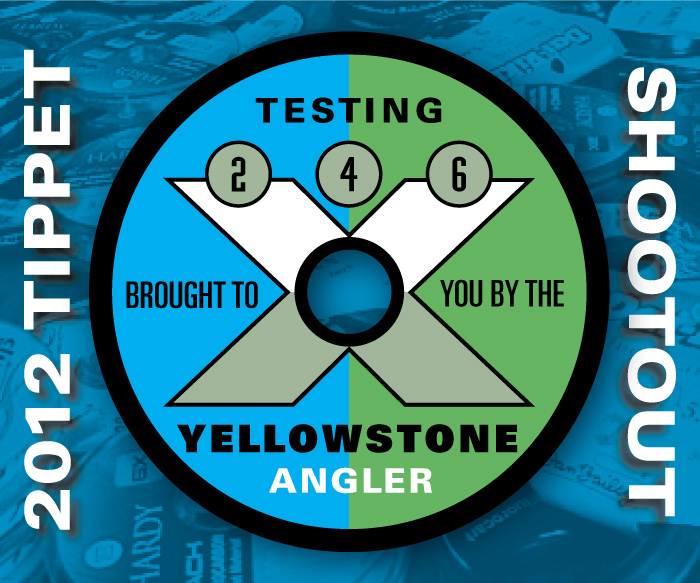
Back in 2012 we wrote a tippet shootout for Fly Fisherman Magazine. Our intent was to post the article on our website soon after but somehow time got the best of us, so…. better late than never? The good news is that we included some new information on tippet-to-tippet knots, tippet-to-fly knots, some new charts, as well as our comments on 22 different tippet materials that were not covered in the Fly Fisherman article.
_______________________________________________
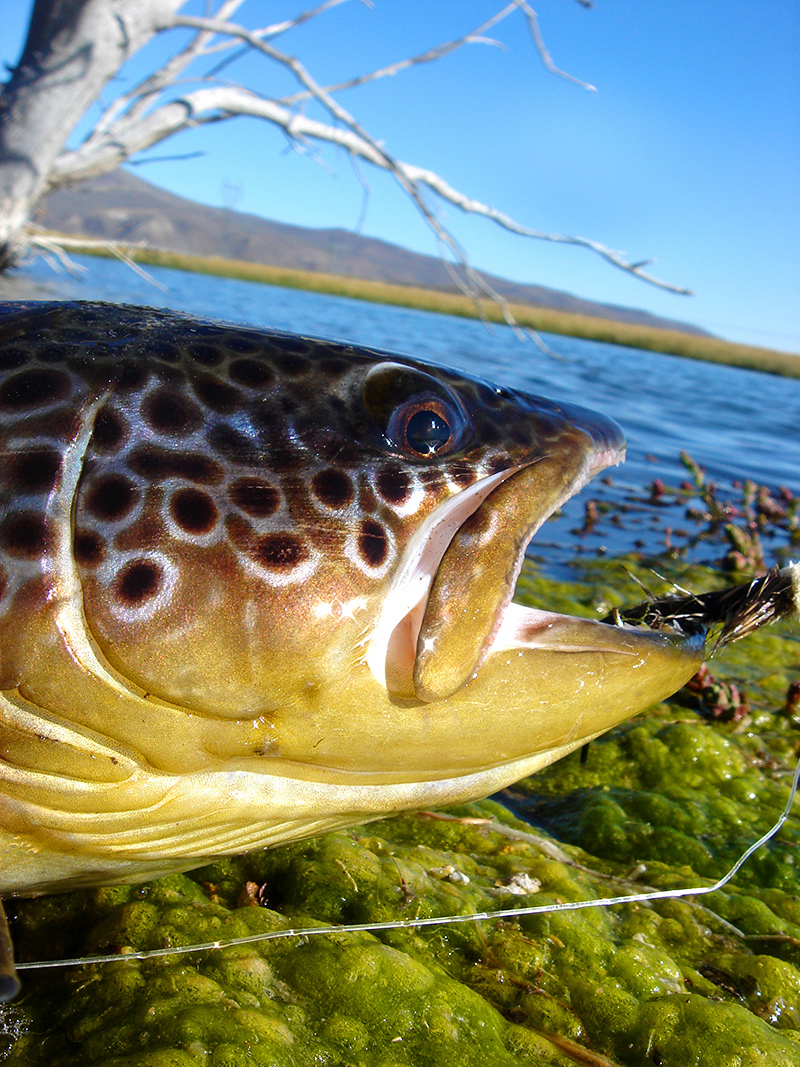
Who makes the best fluorocarbon out there? Seaguar GrandMax / Trouthunter
Who makes the best nylon? Rio Powerflex / Stroft
Which nylon ties the strongest knots? Stroft GTM Nylon
Which Fluorocarbon ties the strongest knots? Seaguar GrandMax / TroutHunter
Which tippet material is the least visible to fish underwater? Fluorocarbons
Which tippet casts more accurately? TroutHunter, GrandMax, Stroft (due to their inherent stiffness)
Which tippet gets the best drift? Seaguar GrandMax FX, Trout Hunter Nylon, Dai-Riki Dynamic
Best Deal per yard? Trout Hunter Fluoro, Rio Powerflex nylon (guide spool), Hardy Mach Fluoro
Is Fluorocarbon really worth the extra coin? Yes, at least for clear running rivers, spring creeks, lakes, and saltwater. If the visibility in the water is between one to two feet, (perhaps just after runoff on a Freestone or after a rain) then it makes more sense to use Nylon since it is cheaper and provides better knot strength than fluorocarbon in the same diameter tippet.
The Davy knot? A popular competition knot, although quick to tie and it wastes very little material, it was one of the weakest knots we tested – even weaker than a wind knot!
Strongest breaking strength average of 2X, 4X, 6X – Seaguar GrandMax / TroutHunter
Strongest knot strength average of all knots tied (tippet-to-tippet and tippet-to-fly) – Seaguar GrandMax / TroutHunter
Weakest breaking strength – Hardy Mach* (thinnest diameter)
Most stretch – Rio Fluoroflex Plus
Thinnest diameter (on Average) – Hardy Mach*
Thickest diameter (on Average) – Cortland Precision Fluorocarbon
Stiffest / most accurate while casting in the wind – Seaguar GrandMAX / TroutHunter / Cortland Precision
Most supple / best drift – Seaguar GrandMAX FX
Most invisible – most fluorocarbons are about equal (we were unable to tell)
Most abrasion resistant – most fluorocarbons are about equal, (perhaps Cortland Precision due to it’s thicker diameter)
Best Price – Hardy Mach
Best all around fluorocarbon – TroutHunter (double structure for knot strength, great spool, better price per yard than Seaguar Grandmax)
Best Spool Design – TroutHunter
* While Hardy had the weakest breaking strengths, they also had the smallest diameters. While we did not test Hardy Mach 1X, 3X, and 5X, we suspect this would have been on par with everyone else.
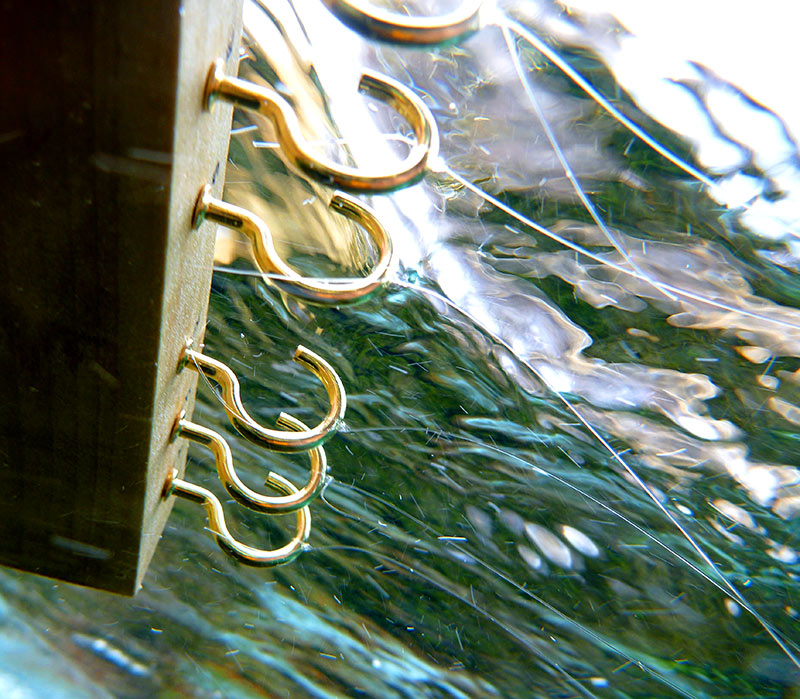
Strongest breaking strength average of 2X, 4X, 6X – Stroft GTM nylon
Strongest knot strength average of all knots (tippet-to-tippet and tippet-to-fly) – Stroft GTM nylon
Weakest breaking strength for 2X, 4X, 6X – Maxima clear*
Most stretch – TroutHunter Nylon
Thinnest diameter (on Average) – Hardy Marksman
Thickest diameter (on Average) – Frog Hair Nylon
Stiffest / most accurate – Stroft GTM nylon
Most supple / best drift – TroutHunter Nylon or Dai-Riki Dynamic
Most invisible – Hardy Nylon / TroutHunter Nylon (since they are thinner diameter)
Most abrasion resistant – Stroft / Frog Hair Nylon (since they are thicker diamter)
Best Price – Rio Powerflex guide spools
Best all around nylon – Rio Powerflex (it always measured at or under industry average/advertised size, strong, and also a good price)
Best Spool design – TroutHunter Nylon
*While 2X, 4X, and 6X maxima had the weakest breaking strengths in our shootout, it tested one of the strongest in 0X, and above. We use Maxima in the butt sections in our hand tied leaders, and love this material for it’s strength, stiffness, and knot durability. Unfortunately we cannot recommend it for tippet 2X or smaller.
_______________________________________________
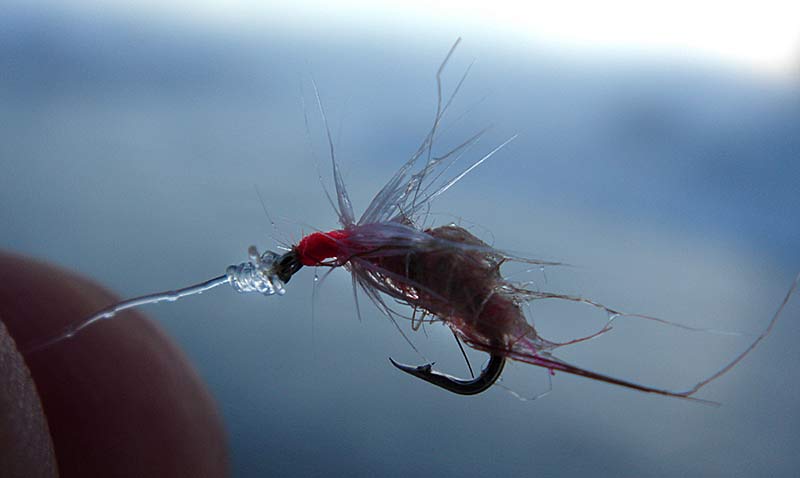
Lee Wulff was once asked, “What is the greatest improvement you’ve seen in fly fishing?” His reply, “The tippet…”
In A. J. McClane’s “The Practical Fly Fisherman,” published in 1953, the author included a tippet chart that rated 0X as 2-pound-test. Today, the best 6X tippets test nearly double that, in fact our 6X straight pull breaking strength averaged 3.78 pounds!
Fly-fishing tippet, as well as the equipment to test it, have also come a long way, even since the 80’s. In 1986 when my father George Anderson conducted his original “Tippet Materials Shootout” in the June issue of Fly Fisherman. Back then, fluorocarbon didn’t even exist. To record breaking strength, George used a bronze, spring-loaded Chatillon fish scale, “eyeballing” tippet breaking strength to the half pound. Somewhat crude, but surprisingly effective, it was groundbreaking at the time. (FYI if you are interested in doing your own tippet comparison, this is a good way to do it).
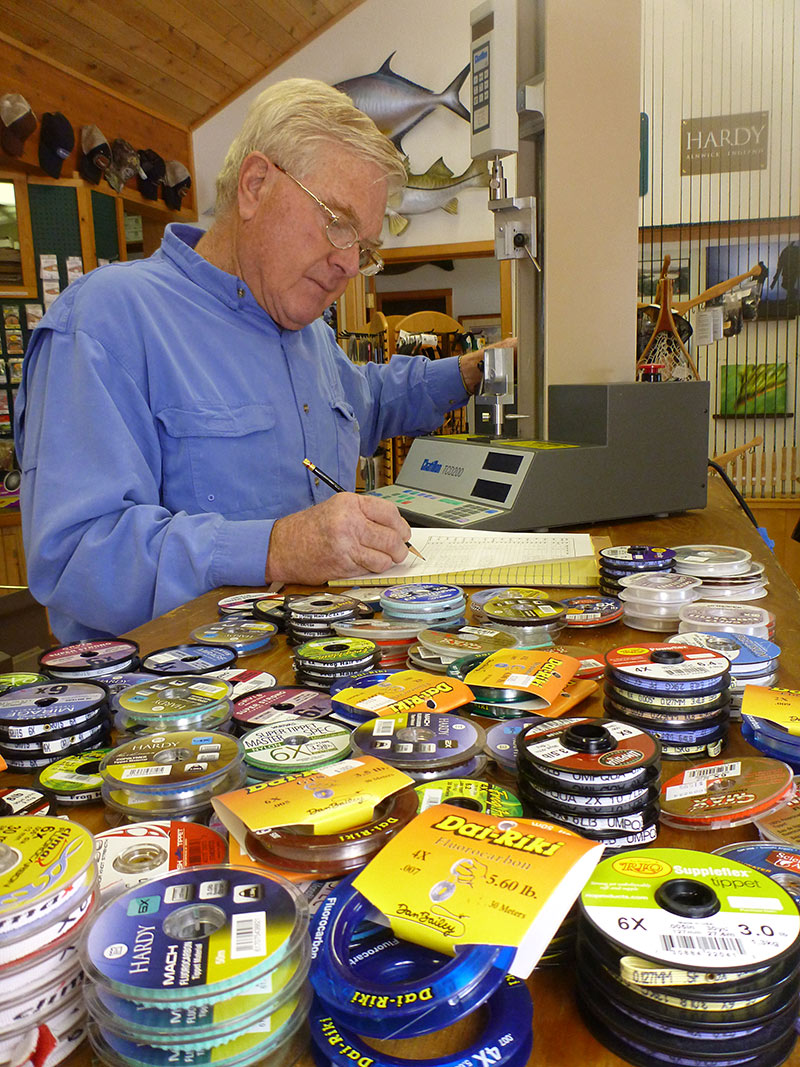
George recording data while using the Chatillon TCD-200 testing machine
More than 25 years later, George and I knew we needed a more scientific way to test tippet materials. Luckily, our friend John Bailey, (owner of Dan Bailey’s fly shop), provided us with his impressive Chatillon TCD-200 testing machine, (which easily costs more than my car and drift boat combined). Equipped with a digital force gauge, it accurately records peak breaking strength to the hundredths decimal place, in pounds. It also provides a measure of stretch, before breakage, to the thousandth of an inch.
If cost were not an issue, an Instron tester, the world’s foremost machine for testing tensile strength would have been the best for collecting our data. However, at a rumored $50,000, these machines are not easy to come by. No doubt, the data collected would have been more accurate, but we did the best we could with the technology we had available.
Here in the US we designate an “X” to our tippet sizes, based on thousandths of an inch. The X system itself can be confusing to beginners. For example, 6X does not mean the tippet is 6-pound-test, it means that tippet diameter is .005 inches. 0X tippet is .011″ and each step “up” in X size is .001″ in diameter smaller.
Most extruded monofilaments are produced in Germany or Japan, and some tippet labels designate their materials in millimeters.
John Stiehl from TroutHunter was kind enough to lend us a micrometer from Japan, which measures from 0.01 to 10 mm. This gave us the ability to measure materials more accurately than we could on our dial micrometer measuring to .001″. For example, 4X, which is .007″, measures .178 mm. If you are in the market for a micrometer, try to find one that reads in mm as they are slightly more accurate.
Chances are, you work for a living and have neither the time nor the resources to test tippet all day. The winters in Montana are pretty cold, so we took the time. After a month of testing more than 30 products and tying over 2,500 knots, we have come to some conclusions.
Haha.. Our first conclusion was that comparing tippet is a complete nightmare! Unlike the fly rod shootouts we do, we couldn’t just pick up a piece of tippet and get a “feel” for it like we can do with fly rods. Instead we had to rely primarily on numerical data.
The first problem we faced with collecting data was how many variables were involved with testing tippet products and tying knots. We did our best to keep everything “apples to apples” but there were numerous variables to juggle at any given time. While we did our due diligence performing each trial to the best of our ability, we’ll be the first to admit that further testing could refine the data we’ve collected, at least in order to make it scientifically valid.
To get truly accurate data worthy of a scientific study, we feel that each strand of tippet, and each knot should be tested 30 times in order to reach accurate averages for breaking strengths. However, if we had taken the time to test 30 materials in three different sizes, 30 times each per strand, it would have taken a lot longer than a month of our time…
In the beginning, we started testing each strand with each knot ten times, but after a day or so of this (and still trying to run a fly shop) we had to narrow it down to six tests per knot. In the case of an aberrant test, we threw the worst test out, leaving five tests to give us a pretty good average. If all six breaks looked consistent, we averaged all six. While less than ideal, this gave all brands a chance to strut their stuff.
One of the biggest challenges we faced was getting an accurate diameter for each tippet strand. We found that the diameter of the tippet on any given spool frequently varied enough to affect our test results. After pulling 3 to 4 feet off the spool, and slowly pulling the tippet though the rubber jaws of the micrometer, we could clearly see the material was not an exact uniform diameter. This was true for tippet from every company. For example, RIO Powerflex 2X ranged anywhere between .225 mm to .230 mm. We tried to use the best average we could and in this case we averaged RIO Powerflex 2X at .228 mm, which came in just under the industry standard of 2X, or .229 mm. As you’ll see in the charts, other companies came in well over the industry average – in affect giving them a strength advantage by being thicker.
In testing the different diameters of these materials, we stated what the manufacturers advertised, but we also reported on how this size varied from the industry standard for a given X size. For example, 4X, which should measure .007″, equals .178 mm. Obviously if a material is substantially larger (or smaller) than the advertised X size, it will test significantly stronger or weaker, which we took into consideration when rating materials. In our charts below you can see the exact size of each material and how it varied from the norm.
Under our Final Results chart, you’ll see which materials we feel are the best and why. In addition to all the laboratory-style tests, we were able to use these materials on the water the summer of 2011, and of course we have fished several of these for years now, providing us with a baseline of knowledge to help judge overall tippet performance.
Over the years, people who have tested monofilaments have come to some general conclusions that we found difficult to prove one way or the other. Below you’ll see some of our “real world” tests in which we tried to test our tippet samples. As you will see several of these tests did not pan out as well as we had hoped. Still, we thought we’d include our findings, hopefully someone out there can pick up where we left off and come up with some better tests.
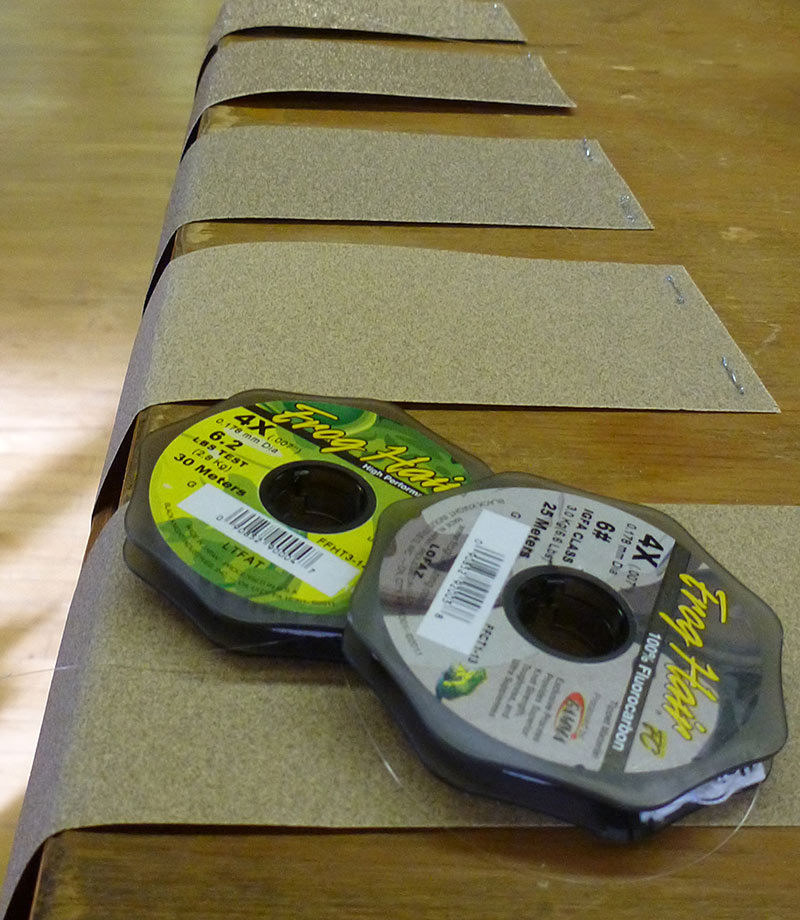
Most fly fishers agree that one of the big advantages of fluorocarbon over nylon is abrasion resistance. This makes perfect sense because the material is denser. From our own fishing experiences, especially in salt water, it seems that fluorocarbon is slightly more abrasion resistant. Of course nothing is going to hold up to a 10-pound bonefish or 25-pound permit running through coral.
We tried to simulate this kind of abrasion resistance by rubbing materials back and forth (with equal pressure) over different grits of sandpaper. It was difficult to see, let alone measure any difference. Since fluorocarbon is denser than nylon, it only makes sense that it is tougher to rub through. We hate taking the manufacturers’ word for it but at this point we’ll have to throw in the towel. All the comments we have gotten from other anglers (especially nymph anglers) support the opinion that fluorocarbon is more abrasion resistant than nylon. We’d love to see the results of a more reliable abrasion resistance test.
Manufacturers regularly claim that fluorocarbon is nearly invisible underwater. Seaguar’s web site tells us that water has a refractive index of 1.33, fluorocarbon has a refractive index of 1.42, and nylon has a refractive index of 1.62. This means that fluorocarbon refracts light more similarly to water than does nylon, thus making it more difficult to see underwater.
While this theory makes sense, we were unable to come up with a scientific method to independently confirm this. Our real world test was to tie 6 different kinds of tippet to 6 hooks that were screwed into a piece of wood. 3 of these were fluorocarbon, 3 of these were mono (or nylon) tippet materials. We then took underwater photos of them. To our eyes (who knows what the fish sees) there did seem to be a subtle difference in terms of how the fluorocarbon refracted and reflected light. Click on the photo below to see more underwater shots to see if you can see a difference…
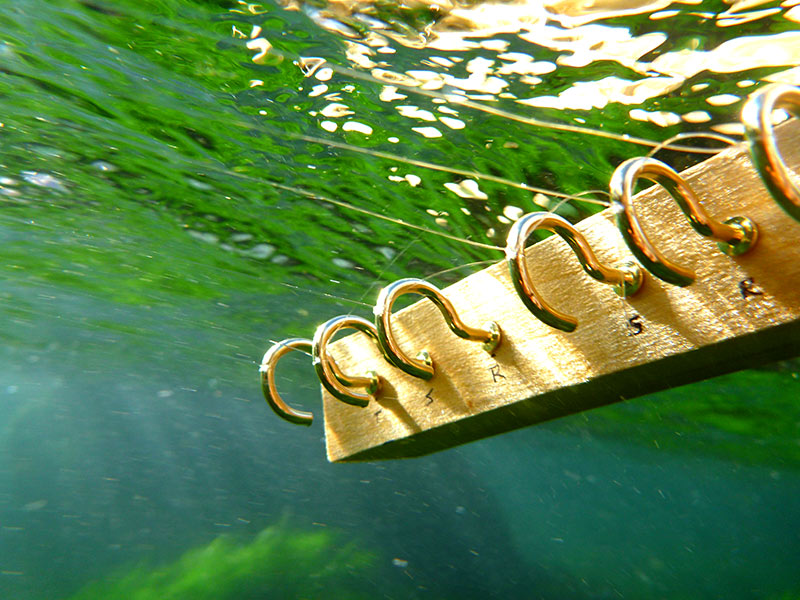
More underwater photos of Fluorocarbon vs Mono
We read an article on line that tested fluorocarbon vs nylon invisibility underwater by allowing tuna to swim into long lines of tippet in a huge fish tank. The tuna more often than not avoided the nylon lines (meaning they could see it) and accidently bumped into the fluorocarbon lines (meaning they couldn’t see it). Interesting…
After years of fishing clear spring creeks, local lakes, and saltwater flats, we have come to the conclusion that the majority of the time, presentation and the action of your fly are crucial to what triggers an eat or initiates a refusal. For the refusals, it is certainly possible the fish was spooked by the light reflecting off the tippet, or that the fish is able to see the tippet itself.
Any advantage an angler can use to get a fish to strike is worth a try. Our own experiences with fluorocarbon in both fresh and salt water seem to confirm that fluorocarbon does make a difference, especially here on the Paradise Valley spring creeks, stillwaters, and salt water flats fishing. We just wish we could have come up with a conclusive test to quantify this difference.
We found no easy way to measure the suppleness of fluorocarbon and nylon. We pulled a few feet of material off the spool and by handling it, we could feel some difference in flexibility, especially for the extreams. The “memory” of a material from being wound around the spool made some materials appear stiffer than others with little or no memory.
One of the ways RIO tests suppleness is to cut lengths of monofilament at exactly 6 inches, and then hang them over the counter. When we tried to duplicate this test it was difficult to tell which materials were softer or stiffer (asside from the obvious extremes).
Also, a material with thinner diameter is by nature more supple, and hangs lower than the others. This is why we shift down in tippet size to get a more flawless, drag-free drift with a dry fly or nymph. In the end, we just went by our gut feeling after handling these materials for long periods of time, running our tests on the machine, and tying all those knots. In general, the fluorocarbons were stiffer than the nylons.
Many good fly fishers have found the stiffness of fluorocarbon to be an advantage in obtaining casting accuracy, especially with fine tippets like 5X, 6X, and 7X. While getting a perfect drag-free drift is the key to technical dry-fly fishing and nymph fishing, good anglers can usually find ways to induce the necessary slack they need to get a dead-drift by mending, feeding out line, or using casting techniques such as a reach cast or slack-line cast.
For these reasons, we feel stiffer materials are better. However, we know plenty of anglers who prefer more supple monofilaments like Dai-Riki Dynamic or TroutHunter nylon, that more easily flow with swirling currents.
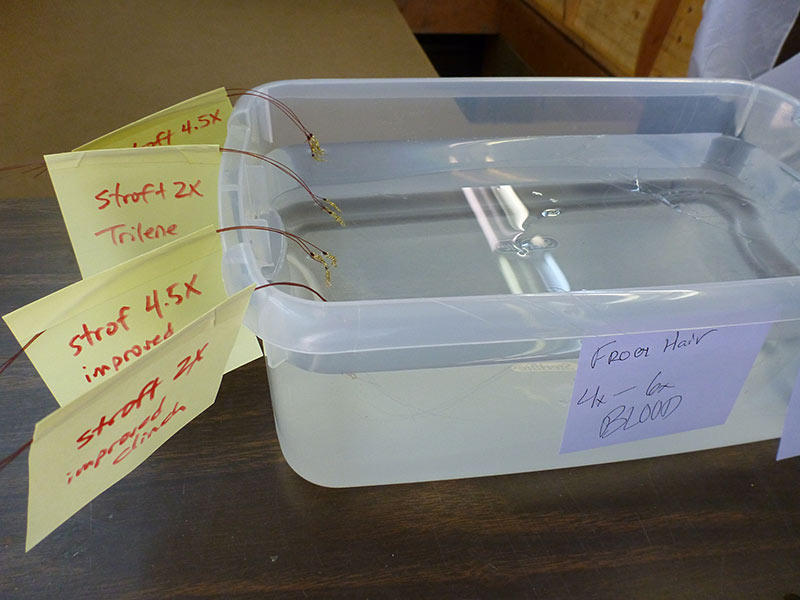
Since nylon absorbs water and fluorocarbon is supposed to be impervious to it, we conducted a few knot tests with materials that had been soaked for 4-5 hours. We found both the straight-pull break strength and knot strength for nylons did decrease – about 20 percent when wet. We found breaking strengths for fluorocarbon also decreased – however only about 3 to 5 percent when wet.
As a practical matter for dry fly anglers, most of the time your tippet won’t be getting soaked underwater more than a few minutes at a time. If trolling is part of your program, or nymph fishing out of a boat (where you cast once and then try to keep your nymphs underwater as long as possible) then you might consider fishing fluorocarbon over monofilament as it won’t get softer overtime and won’t become saturated with water.
Anglers sometimes worry about fluorocarbon sinking more rapidly, since it has a heavier specific gravity than nylon. (The specific gravity of water is 1.0, nylon has a specific gravity of 1.05 to1.10, fluorocarbon is denser and runs 1.75 to 1.90.) To put this in perspective, tungsten, used as a powder in sinking tips, has a specific gravity of 19.25. So there really is not a substantial difference between nylon and fluorocarbon, especially when most anglers are just using fluorocarbon for the tippet.
A much bigger factor is surface tension. If you are using small-diameter tippets and a small dry fly, the surface tension won’t usually allow either nylon or fluorocarbon to break through the surface. This seems to apply especially for tippets 3X or smaller.
Also, once the tippet material has broken the surface tension and is under the water, there is almost no practical difference in the sink rates of nylon or fluorocarbon tippets.
If you are using a full tapered leader of fluorocarbon, only then does the weight become slightly more of a factor in terms of sink rate and breaking the surface tension more easily.
For the first round of our shootout we focused on tippet diameter and straight-pull break strength. The materials that had larger diameters, yet lower breaking strengths, went to the bottom of the list. In general, the materials that tested within industry average—yet had the highest breaking strengths—moved on to our knot shootout. We wish we could have tested knot strength for all brands of nylon and fluorocarbon; we simply didn’t have the time. For our final shootout, we limited the results to what we determined were the top three fluorocarbons, and the top three nylons.
For fluorocarbon, the top three materials based on average breaking strength and correct diameter were Seaguar Grand MAX, TroutHunter, and RIO Fluoroflex Plus. With RIO holding the greatest market share and having the most stretch out of all the fluorocarbons tested, we were curious to see how it would compare. As you will see in the charts, Rio Fluoroflex did great with straight pull breakes, however once knots were introduced into the tippet, TroutHunter and Seaguar Grandmax held much stronger knots and were clearly the true winners of the test.
For nylon, Stroft GTM, RIO Powerflex, and Dai-Riki GTS had the strongest average breaking strength by diameter. However we decided to include Frog Hair rather than Dai-Riki GTS, due to Frog Hair’s higher breaking strength in 4X and 6X, (since most people don’t typically break fish off on 2X).
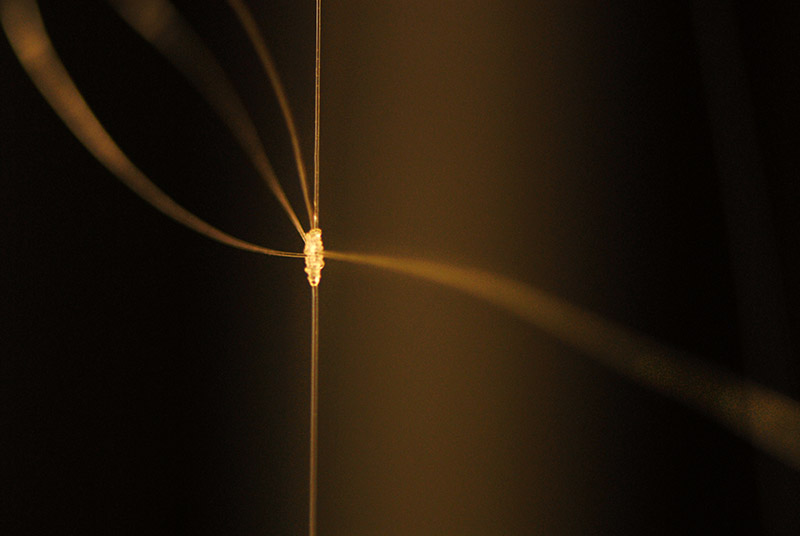
In the end, our “Tippet Shootout” ended up being more of a Knot Shootout. We had not anticipated putting so much emphasis on the knots until we noticed that once knots were introduced into the equation, breaking strength immediately decreased by 20 – 30 % and with some brands of fluorocarbon as much as 50%!
Clearly knot strength is even more important than straight-pull break strength of the material itself (unless you’ve figured out a way to fish without knots). By looking at the tables below, you can see which knots perform the best and then learn how to tie them quickly yourself. We found Net Knots.com was one of the best places to learn these knots since they provide animated videos rather than just step-by-step graphics which are harder to learn from. Click on each of the Net Knots diagrams to take you to the corresponding animation. Some knots are easier to tie than others, and most anglers prefer to stick to the easiest knots, even if they are slightly weaker than the very strongest knots.
When we crunched the data, the weakest link ended up being tippet-to-tippet knots. This was a surprise, since our angling experience suggests that the tippet-to-fly is the weakest link, (especially when using the non-slip mono loop knot to tie on your fly for more action). Further tests we did with a rod rigged up out on the lawn confirmed that the tippet-to-tippet knot broke more often than the tippet-to-fly knot.
Note: The past two years since we did the tippet shootout I’ve made a point to notice where my weakest link was with breakoffs and sure enough it was usually a tippet to tippet connection rather than tippet to fly. This is one reason we started using tiny swivels (or tippet-rings) since the connection from tippet to metal is stronger than tippet to tippet. For example I will run 2X to a small swivel and have 4Xor 5X on the other side of the swivel rather than tying a 2X to 5X blood knot.
To our surprise, the J knot proved to be the strongest line connection knot, at least for joining materials from 2X to 4X and 4X to 6X. One of our all time favorites, the improved blood knot proved to be strong as well, and is noticeably smaller than either the J knot or a triple surgeon’s knot, making the knot less visibile to fish and also easier to go through your guides if/when necessary. The standard blood knot and triple surgeon’s knot, used by the wide majority of anglers, turned out to be slightly weaker but still pretty darn good.
The good news is that the improved clinch, which almost everyone uses to tie on their flies, ended up testing the third strongest out of 15 different tippet-to-fly knots. Only the San Diego jam and double improved clinch averaged stronger breaks.
We were also surprised to see that the Davy knot, which is fast to tie and therefore popular in competitive fly-fishing circles, actually tested weaker than a wind knot! (In many fly fishing competitions, time is more important than knot strength, as many of the anglers know how much pressure they can get away with).
In general if you learn the improved clinch and blood knot you are good to go. If you would like to have an even stronger system then it’s worth it to learn the Stu Apt Improved bloodk knot, the J knot, or the San Diego Jam.
In order to determine which material produced the strongest knots, we averaged the breaking strengths of 2X, 4X, and 6X for each of the 22 knots we tested with each material. For our final results, we had to factor in the diameter of the material we were testing, since larger diameters would obviously test stronger. For example, in several cases, Stroft or Frog Hair had the strongest breaking strengths, but we had to handicap them for being slightly over the industry’s average diameter.
In straight-pull break strength, when we averaged the figures, fluorocarbon proved to be stronger than nylon. Once we added knots into the equation however nylon was stronger. The differences were not huge, but we gathered enough evidence to declare nylon the clear winner in knot strength. But in our own fishing experiences we have felt that the fluorocarbons have provided sufficiently strong and reliable knots, especially when we’ve used a lubricant like lip balm in tying the knots. Perhaps as an angler you have to decide what is most important to you – breaking strength or invisibility to the fish.
One thing that we have noticed over the years, is that fluorocarbon is a lot easier to get untangled than nylon. If you are guiding it may seem counter intuitive to use fluorocarbon due to its expensive price, however if it enables you to get your tangles undone faster it may be well worth it’s weight in gold. You’ll be less frustrated at the end of the day, you won’t have to anchor and let the other boat by, and you might even get a bigger tip out of it at the end of the day.
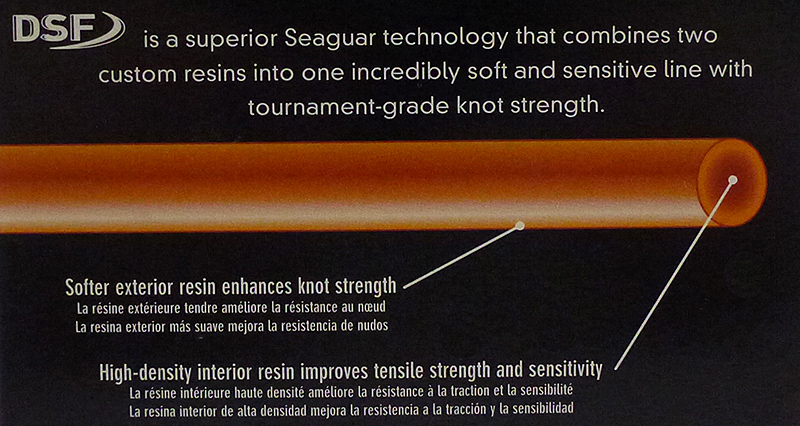
From experience we know that fluorocarbon tippet ties well to nylon leaders. The best we’ve found though are Seaguar Grand MAX and TroutHunter because these are the only two fluoroarbons we’ve found on the market with a “double structure.” A high-density interior resin improves tensile strength and sensitivity, while the softer exterior resin enhances knot strength. This softer exterior is close to nylon, allowing for better grip and stronger knots. So there you have it – the best of both worlds, invisible yet also allows stronger knots. Bottom line, if you are going to pay the difference to fish fluorocarbon, choose between TroutHunter or Seaguar GrandMax.
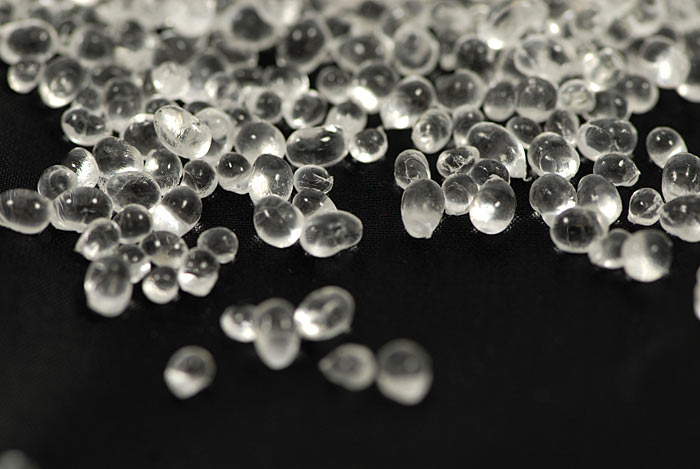
A close up shot of what Rio Powerflex Nylon looks like before it is melted and extruded.
This one’s easy. The least expensive tippet per yard/meter gets the highest points. Sometimes a tippet material will appear more expensive than another, for example TroutHunter Fluoro ($22.95) at first glance appears more expensive than Seaguar GrandMax ($18.95). However when you look more closely at how much it costs per meter it is actually cheaper than GrandMax (since they offer 50 meter spools in 0X-8X, instead of 25 meter spools). If you are on a budget then Nylon will be your best tippet material – especially if you go with Rio Powerflex in the guide spools.
Here we take a close look at each brand’s spool design. Those who scored the highest points had spools that clip together, that were not bulky, that had easy to read tippet tenders, and that had spools which the material was able to come off smoothly without damaging it in anyway. Some spools (like Varivas) were designed to clip together but had trouble clicking together (and staying together) while others like Orvis clicked together well but were difficult to pull apart. Some brands had excellent tippet tenders like Rio (which at the time were color coated and also had easy to read information on them like what X, what pound test, and its diameter). Others had a very skinny tippet tender (like Hardy) while Maxima doesn’t provide one at all. In hind sight, perhaps we should have only given spool design 10 points since it’s not essential to tippet performance.
We’ve never taken the manufactures word for it, especially with tippet which is an easy thing for manufactures to fudge inorder to look better. Here we take a look at what each manufacture says their tippet diameter is, and then we compare it with what the tippet actually mic’d out at on the peacock micrometer. Manufactures that were close to the truth (or told the truth exactly) scored the higest points. We found that with each brand sometimes their 4X was thinner, while their 2X was bigger and took that into consideration and averaged their advertised size vs actual size.
Just like tippet size we found manufactures like to fudge on their tippet’s strength. Manufactures that reported accurately on the actual straight pull breaking strength (without knots) got the highest scores.
The Industry Average is what manufactures in the US are calling 2X, 3X, 4X, 5X, 6X, ect. For each “X” a tippet material is supposed to be a certain diameter, although obviously a manufacture could extrude a material and thus make it stronger than competing brands – the down side is that their material will be easier for the fish to see and also a thicker material won’t get the same drift as a thinner material. Manufactures who scored high in this category kept their material at or under the industry average. Companies who over sized their tippet diameters to gain strength were marked down.
Here we take a look at how consistent each brand is at keeping their tippet at or under the industry average for 2X, 4X, and 6X. We found that nearly every single brand’s 2X was larger in diameter than it was supposed to be, (further suggesting that a handful of factories are extruding tippet material for multiple brands). We also discovered that some brands pay more to “check” on the diameter of their tippet material more often during the process of extrusion. This is more expensive but it ensures better consistency for the diameter. Brands with the high scores in this category had an average or under average for the industry standard for diameter in 2X, 4X, and 6X.
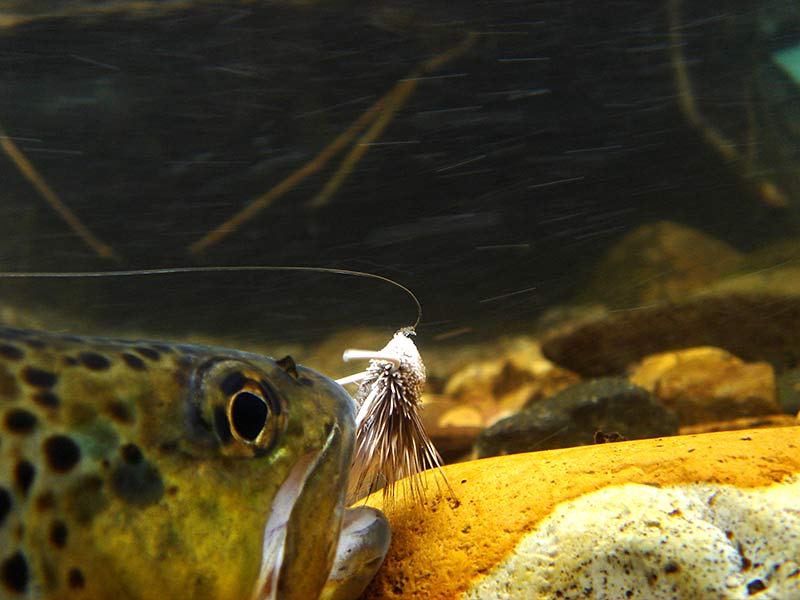
Here we averaged each of the straight pull breaking strength for each brand in 2X, 4X, and 6X and compared who was stronger. Brands that have high scores here had stronger breaking strengths than their competition. We also took into consideration the diameter of each brand’s 2X, 4X, and 6X – so if someone’s 4X was way thicker than it should have been (and thus be stronger) we made sure to score them accordingly. Brand’s with thinner, stronger tippet won.
Here we compare each brand’s tippet-to-tippet knot strength scores. Obviously those with the strongest breaks scored highest. We found it interesting that the nylon materials were strongest here. The two fluorocarbons that did well were TroutHunter and GrandMax, who are the only two materials that are using a double structure tippet, with a hard inner core fluorocarbon material, wrapped with a softer outter fluorocarbon.
Just like the tippet to tippet version, here we take a look at which brand’s had the strongest average breaking strength when the tippet is tied to a fly (or in this case a small swivel with the same thickness as a size 10-12 hook). Once again nylon materials reigned supreme, followed by the two double structure flourocarbons, TroutHunter and GrandMax.
While no one wants a wind knot in their leader, somehow they have a way of showing up. Even the best casters in the world are bound to throw a tailing loop or an inaccurate cast at some point. We wanted to know which brands of tippet allowed the angler the best chance of landing a huge fish with a wind knot. Some Alaska guides will even put a wind knot in the tippet on purpose to keep a split shot from sliding down. We thought for sure all the nylons would win here, but Rio Powerflex proved to be the best nylon. Frog Hair Nylon and Stroft ended up having the same strength as TroutHunter and GrandMax, while Rio FluoroFlex was the worst, instantly cutting through itself.
We didn’t have a great answer on how to test abrasion resistance. It is difficult to see which materials would hold up best to hitting underwater rocks or coral. In the end we rubbed each of the materials on different grades of sand paper to see which ones held up best. While it was difficult to tell the differece between each brand of Fluoro and Nylon, it was clear that the more dense Fluorocarbon was indeed more resistant to breaking when rubbed against the sand paper.
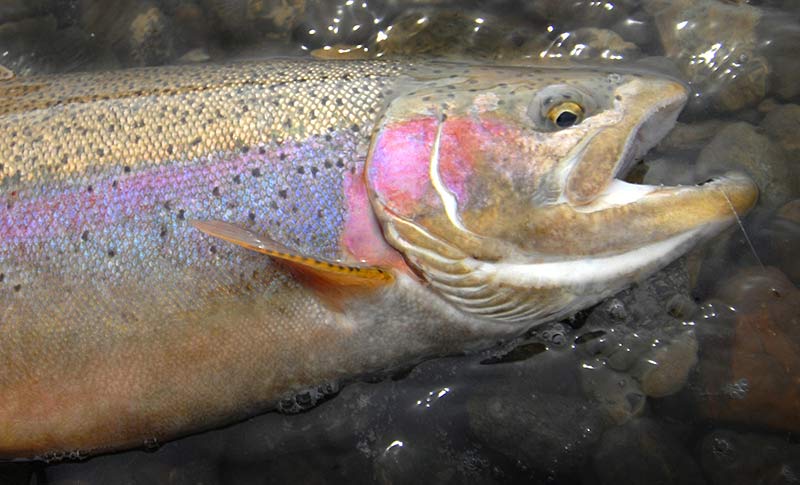
Another category that was difficult to test, we tied the winning materials to some hooks on a wooden dowl and took photos of them underwater. While we really have no idea if the fish see it differently, to our eyes the fluorocarbon definitely looked more invisible, especially when it refracted light. This test, along with the tuna reseasch (scientists rigged up several fluoro and nylon lines in a tuna tank and counted that the tuna ran into the fluorocarbon more often) suggest to us that fluorocarbon is more invisible to the fish.
From our own experience fishing spring creeks in the wind (Livingston provides a great enviroment for that) we’ve come to the conclusion that stiffer materials are better when it comes to casting accuracy. While manufacture reps can argue that softer is more accurate, you rarely ever see casting comeptition anglers using supple tippet. Almost all of them use stiff materials, whether they are fluorocarbon or nylon. We found out through friends that one of the most preferred materials for casting competitions is Stoft, since it is incredibly stiff, slightly oversized, and great at turning over. TroutHunter and GrandMax were stiffer than Rio Fluoroflex and also had less stretch than Fluoroflex tippet.
Here we talked to about 25 of our close friends, (many who are outfitters or guides) and asked them what kind of tippet they are fishing for themselves. We found that many of them actually fished something slighly different for different occasions but we found it interesting that nearly all of them were fishing fluorocarbon the majority of the time.
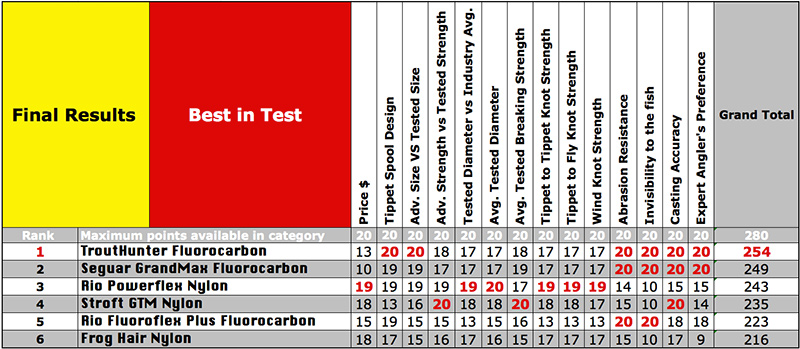

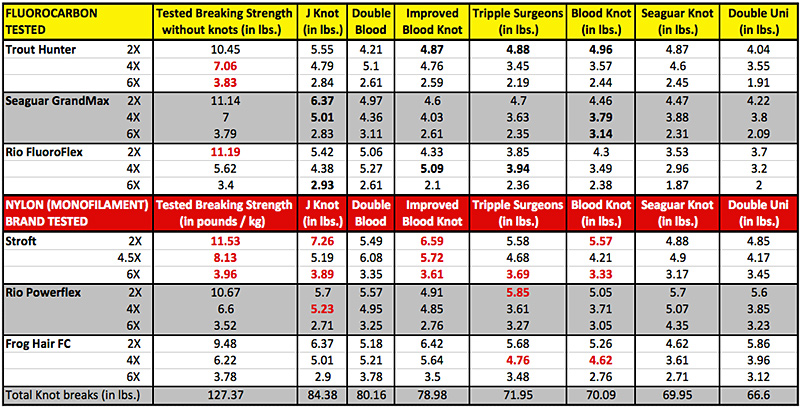
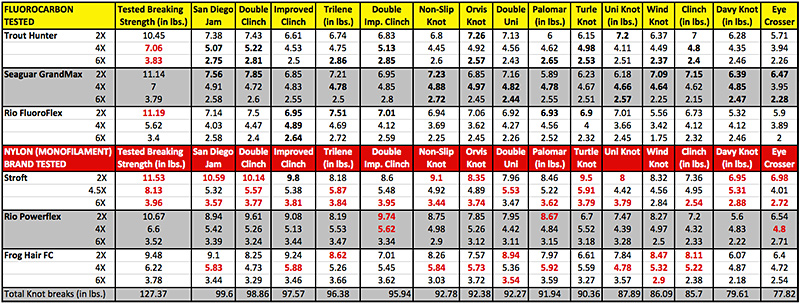
As in our rod shootouts, we came up with a system to rate the tippet materials we tested based on our best opinions after examining each category. Overall, TroutHunter finished first, although scores were very close. Seaguar GrandMAX was a close second, followed by Rio Powerflex nylon.
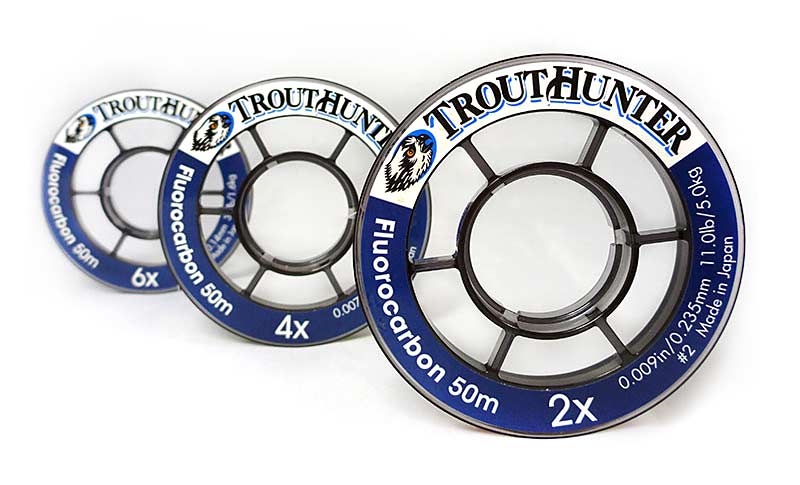

In our closest shootout ever, TroutHunter is our 2012 tippet shootout winner by a hair. While TroutHunter’s double structure fluorocarbon consistently produced exceptional breaking and knot strengths throughout our tests (like Seaguar), what really set this material apart from the competition was its price and outstanding spool design. While the $22.95 price per spool may give buyer’s initial sticker shock, at .46 cents/per meter it is a great value. You get more than twice as much material on each spool compared to 23 – 30 meters on the competitions spools. TroutHunter fluorocarbon pulls of the spool perfectly smooth with no line memory or damage to the tippet. The color-coded bands are both water and UV proof, which will protect your material from the elements.
Note – starting in 2014 TroutHunter now stocks 01X, 02X, and 03X – however due to the thickness of the material, these spools are only offered in 25m spools.
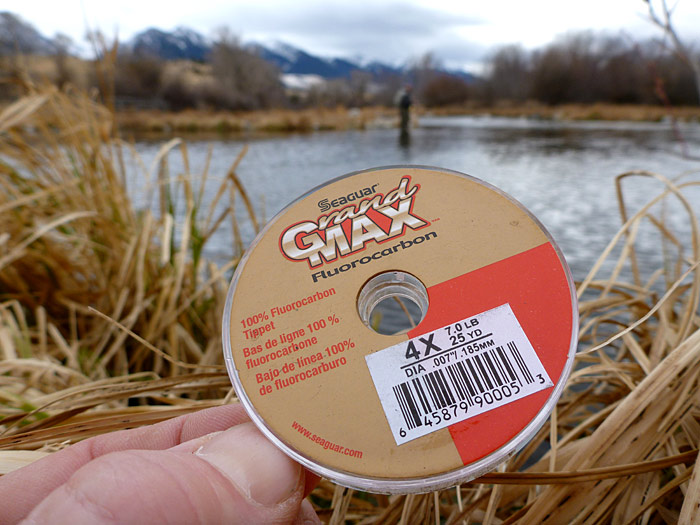

Seaguar GrandMax as well as GrandMax FX has both been very popular here at our shop, providing us with maximum confidence on the water for over the past 10 years. Seaguar‘s double structure design consistently placed them on the top for knot breaking strengths. The only limiting factor for Seaguar has been it’s cost. At .69 cents/meter it is the most expense material we tested.
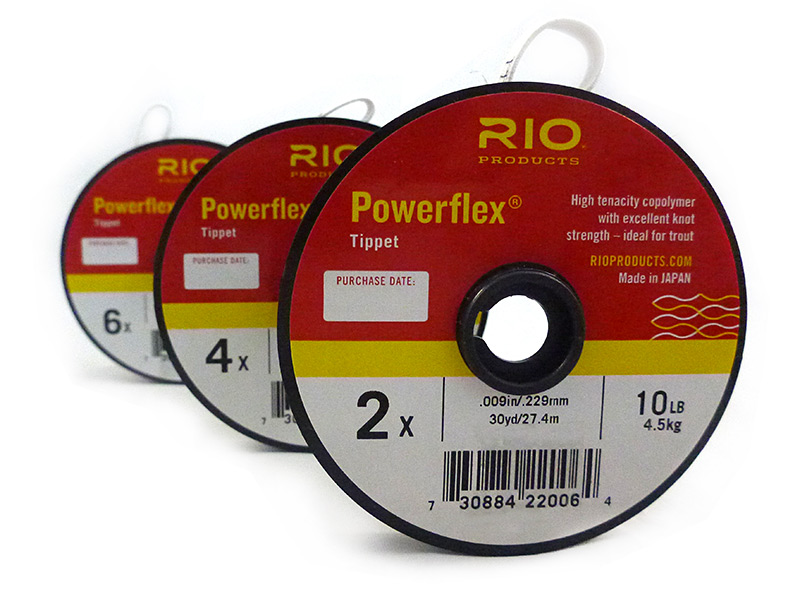

Rio Powerflex offers anglers the best bang for their buck out of any of the tippets we tested. It was one of the top materials for best all around knot strength and stayed close to standard diameters, actually measuring slightly smaller in most sizes. Rio Powerflex is definitely the winner for price conscious anglers, which is why we probably see this material in more guide boats than any other material tested.
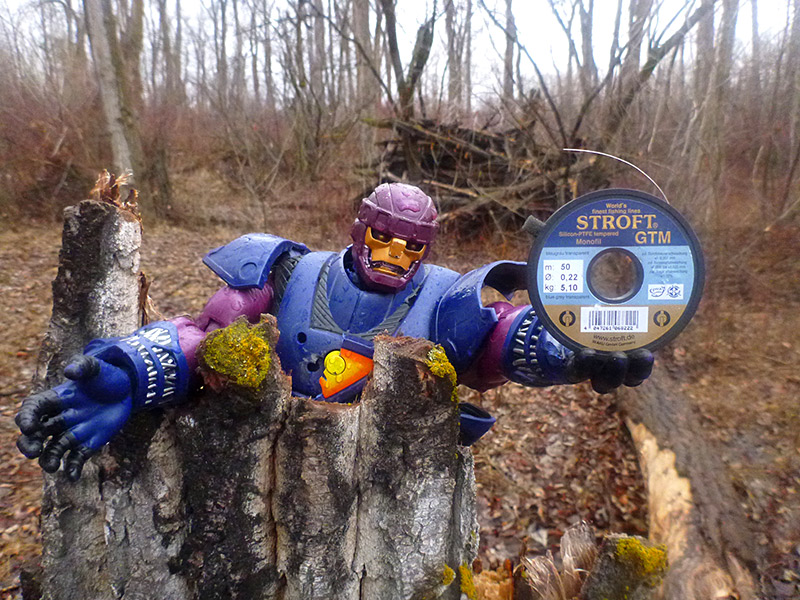

Our top pick for overall knot strength, Stroft has found a place in our vests and sling packs here at the shop. By incorporating half sizes into their product line, Stroft offers anglers more versatility on the stream. Since it is one of the stiffest materials we tested, it is also one of the most accurate. While beginners may struggle to get a perfect drift with this material, for competition casting and the ultimate accuracy, we feel Stroft is second to none. The only downsides were their poor spool design and slightly higher average cost than other nylons.
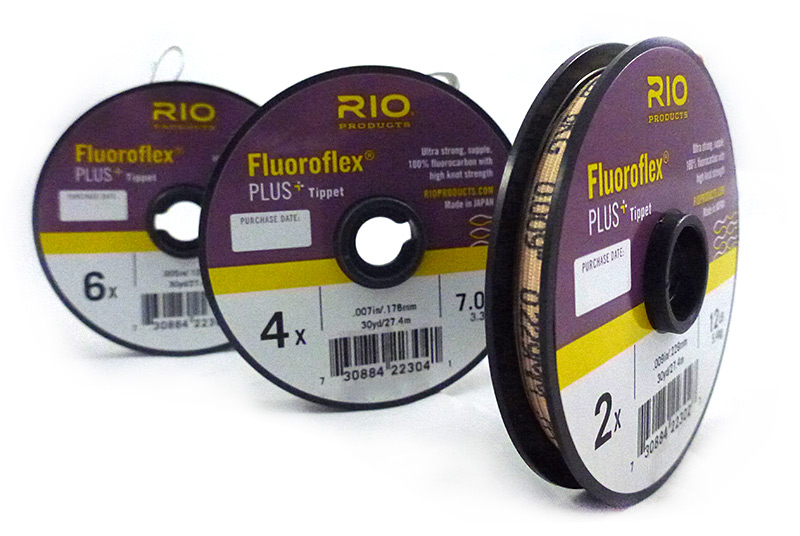

Overall, we found that Rio Fluoroflex Plus offers anglers a good material at a reasonable price for fluorocarbon, but it did run oversize. While 6X measured very close to the standard, 2X measured slightly larger than 1X, and 4X measured about 3.5X. Even running larger than other fluorocarbon materials tested, its knot strength was far weaker than the double structure fluorocarbons. One advantage that hard-core anglers and guides appreciate is the fact that it is available in 100 meter guide spools that incorporate a well-marked spool tether, making it easy to distinguish the spool’s size.
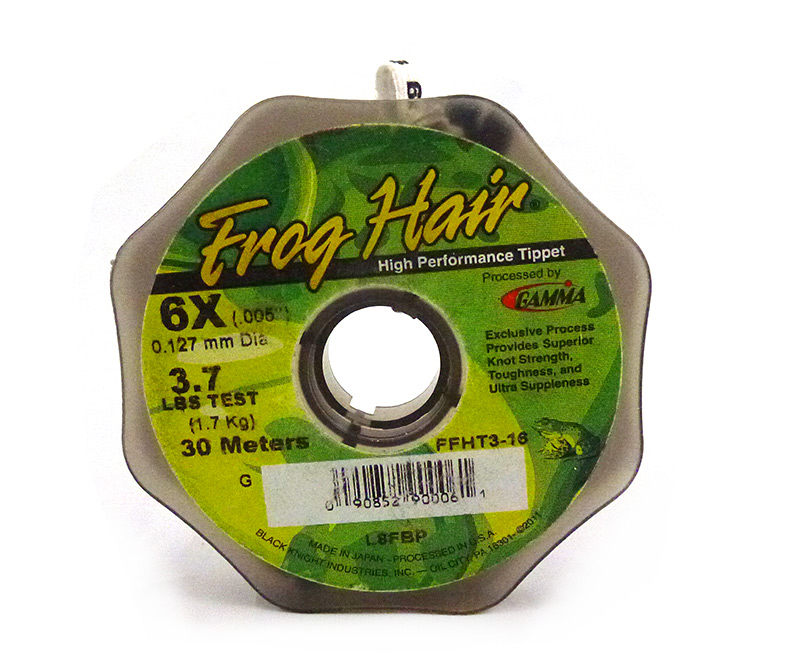

Frog Hair proved to be an exceptionally strong and produced some of the loudest tippet “pops” when the material broke finally snapped. Frog Hair had the strongest 4X in our test, (while still measuring very close to the industry standard). Once we included the 2X and 6X average diameters however, it did run somewhat oversize compared to other brands. Frog Hair is one of the harder nylons that we tested, which lends itself well to accurate casting and better than average abrasion resistance, we just wish it was a little more consistent with knot stength.
Putting more emphasis on price and knot strength, our shootout proved nylon materials to be the runaway winners. That being said, almost every expert angler we know fishes with fluorocarbon, despite it’s higher cost. Experienced anglers feel that fluorocarbon’s increased abrasion resistance leads to fewer lost fish, and the decreased visibility underwater leads to more takes, especially in critical conditions where the fish are getting a very clear look at your fly. In addition, increased casting accuracy pays huge dividends in making it easier for you to put your fly on the exact drift line time after time. Break strength and knot strength for the best Florocarbons, although not quite up to the best nylons, has proven to be very good, as has the overall reliability of a system utilizing a nylon leader and fluorocarbon tippets.
Bottom line – line you’re going to spring the extra money for Fluorocarbon, buy a double structure fluorocarbon like TroutHunter or Seaguar GrandMax. If you don’t feel like spending the extra money, buy Rio Powerflex, which tested very strong for its diameter.
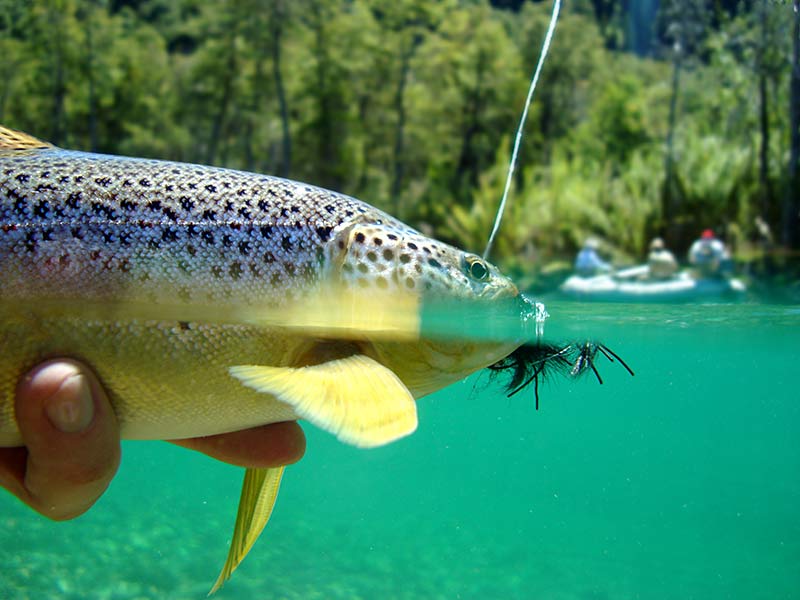
____________________________________________________________________________________
Below you’ll find the additional information which we weren’t able to publish in Fly Fisherman due to limited space. Here we take a look at all the different materials tested. First we’ll look at the Nylons, followed by the Fluorocarbon.
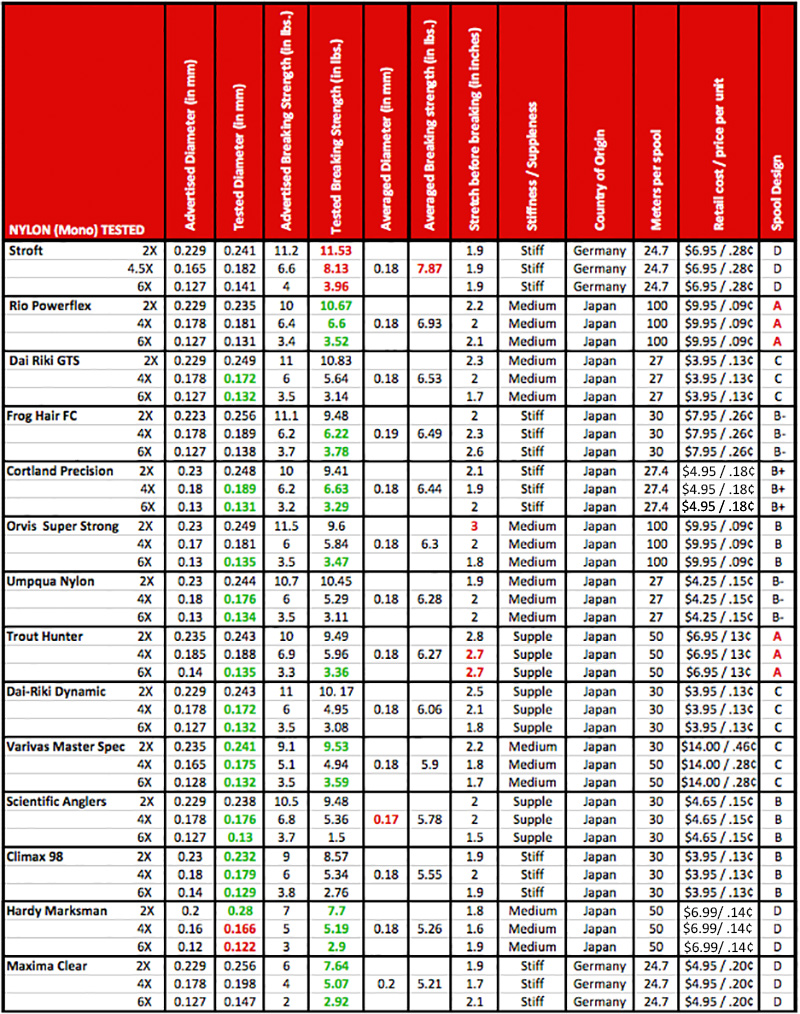
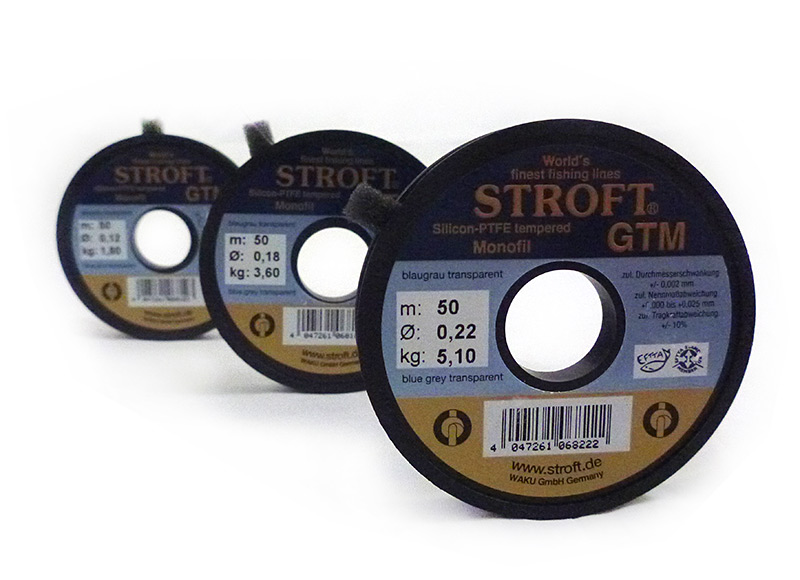

Our top pick for overall knot strength, Stroft has found a place in our vests and sling packs here at the shop. By incorporating half sizes into their product line, Stroft offers anglers more versatility on the stream. Since it is one of the stiffest materials we tested, it is also one of the most accurate. While beginners may struggle to get a perfect drift with this material, for competition casting and the ultimate accuracy, we feel Stroft is second to none. The only downsides were their poor spool design and slightly higher average cost than other nylons.


Rio Powerflex offers anglers the best bang for their buck out of any of the tippets we tested. It was one of the top materials for best all around knot strength and stayed close to standard diameters, actually measuring slightly smaller in most sizes. Rio Powerflex is definitely the winner for price conscious anglers, which is why we probably see this material in more guide boats than any other material tested.
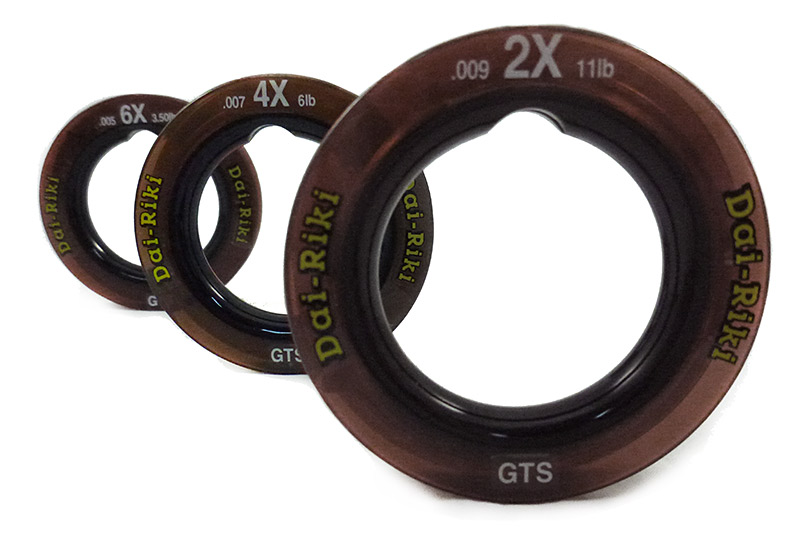

Our tested diameters for Dai-Riki GTS came out very close to their advertised diameters. Only in 2X was it over size. In 4X it was actually under the industry standard and in 6X it was only a tiny bit larger. While straight pull break strengths were not as strong as some, when taking diameter into consideration, GTS is right on par with most good nylons. Back in 1986 when George first conducted a tippet shootout, Dai-Riki was one of the strongest materials available.
Since Dai-Riki spools don’t clip together, plan on using some kind of tippet leash, (or simply have them loose in a designated boat bag pocket). Also it works better to pull the material off the spool slowly to avoid the plastic tippet tender from hopping up and down. Dai-Riki is great stuff at rock bottom prices.


Frog Hair proved to be an exceptionally strong and produced some of the loudest tippet “pops” when the material broke finally snapped. Frog Hair had the strongest 4X in our test, (while still measuring very close to the industry standard). Once we included the 2X and 6X average diameters however, it did run somewhat oversize compared to other brands. Frog Hair is one of the harder nylons that we tested, which lends itself well to accurate casting and better than average abrasion resistance.
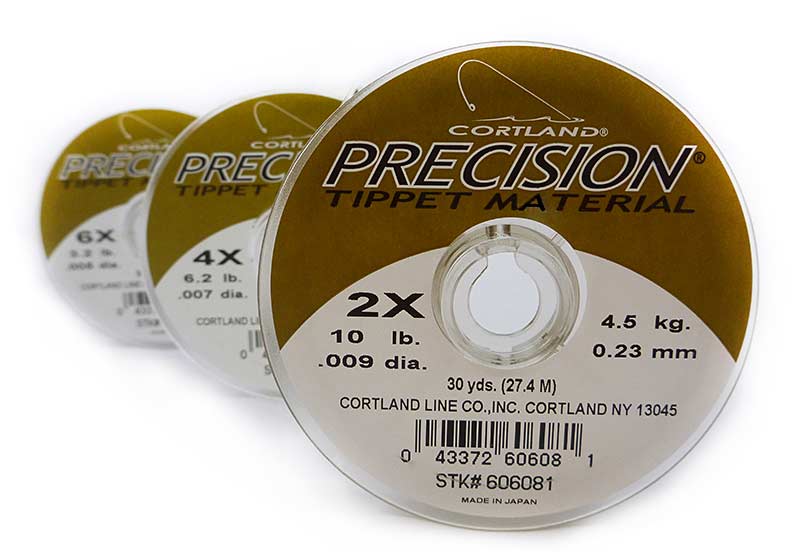

Like most brands, Cortland’s 2X was significantly larger than the industry standard but in 4X and 6X it ran only a tiny bit over. It’s straight pull breaking strengths were not nearly as strong as other materials of similar diameter. At least the breaking strength we tested more or less jived with their advertised breaking strengths, testing even stronger than what they advertised for 4X and 6X, which is respectable on their part.
Cortland Spools are a clear version of of Rio’s “Tippetmater” spools, even produced under the same patent number and made in the USA. Since UV rays can damage nylon tippet over time, we felt black was a better option but as long as you keep your tippet in a pocket or bag while you’re not using it, this should be a non-issue. Cortland’s tippet tender is also extremely similar to Rio’s, equipped with the same brass hole for tippet to pass through. While Cortland also marks which “X” each material is, Rio’s tenders are slightly better as they are color coded and include the lb test, kg test, diameter size in mm / inches as well as the corresponding “X”. Cortland Precision nylon seems to be an excellent material at a good price.
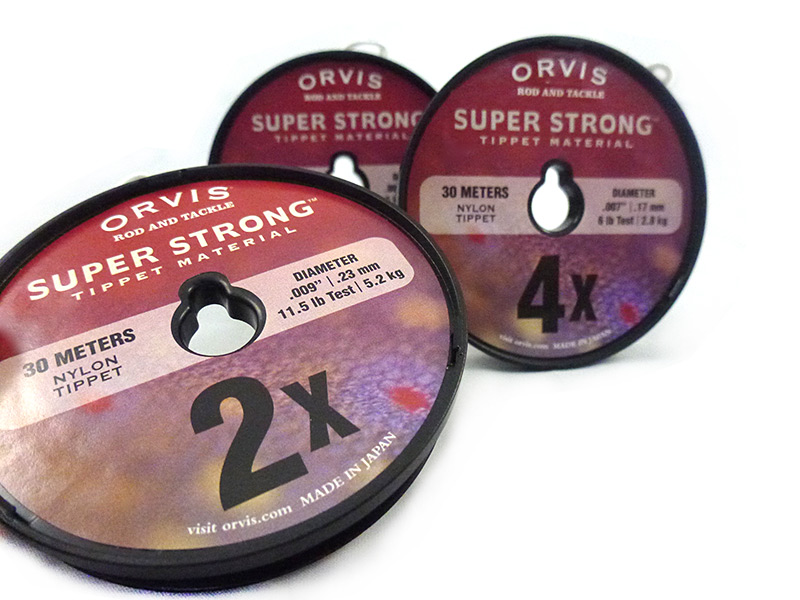

Orvis nylon tippet has always had a strong following at our shop, and nationwide – and for good reason – it is super strong! A major leading factor towards their super strength however, is due to it’s over sized diameters. Orvis Super Strong 2X is actually closer to 1X. If you are looking for a material with slightly thicker diameters for better abrasion resistance and also slightly better casting accuracy (through a stiffer material) then Orvis Super Strong is a great option. If you are more concerned with getting a flawless drift, either look at brands with thinner diameters in general or consider using one size smaller size X tippet than you usually would fish with Super Strong.
Orvis came out with a new spool design this year. We like the switch to black instead of clear, as well as the larger arbor. Also, their tippet tender has been improved with a wider brass hole for the tippet to pass through and a wider tender, making it easier to read which “X” the materials are. Unfortunately the way the spools click together is more difficult to click together and especially more difficult to pull apart. Orvis should look into getting the same spools as Rio and Cortland. Super Strong indeed!
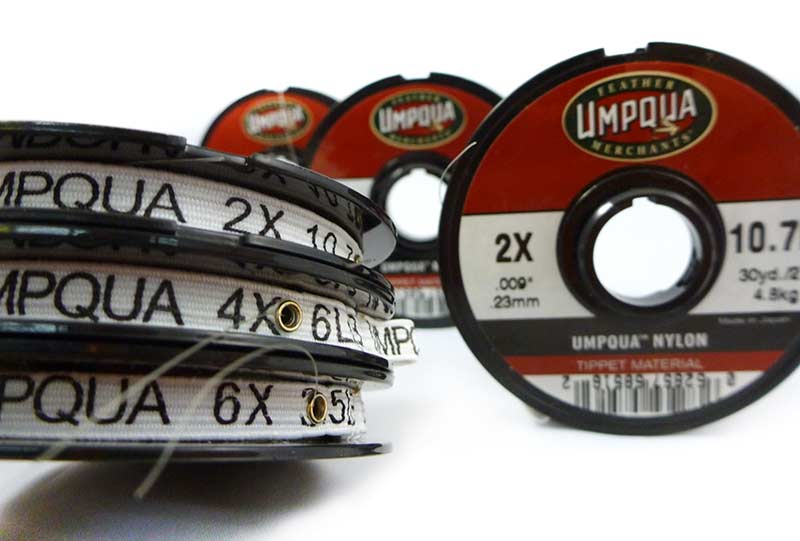

Umpqua’s balance of diameter, breaking strength, and suppleness makes for a very well rounded tippet. While 2X was still significantly over sized, our tested diameters in both 4X and 6X came in under the industry average, which means Umpqua nylon is a good choice for technical nymph fisherman that are looking for the perfect drift since it is softer and more supple than other nylons. With tested breaking strengths reasonably close to their advertised pound test and over all thinner diameters, Umpqua earns our respect by keeping it real.
Umpqua’s spools are well thought out with black, UV resistant large arbor spools. We like their tippet tender (same as style as Rio’s) except they are all white and are labeled with the appropriate “X” and pound test. Their spools click together well, and once you learn to adjust your grip while pulling tippet off, the material comes off smoothly. One of the softer, more flexible materials we tested.
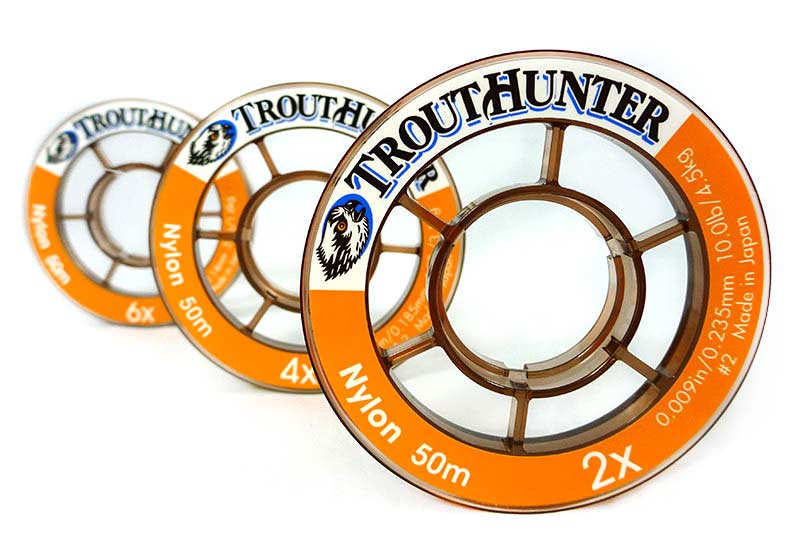

The main reason to purchase TroutHunter nylon is for it’s exceptional stretch and suppleness. Only Dai-Riki Dynamic felt equally as stretchy and supple. The extra stretch we found in TroutHunter nylon could be an advantage for anglers that have a tendency to strike a little too hard, or for angler’s who want to achieve the best drift possible. The only downside we found, was that TroutHunter nylon was significantly weaker than other brands, therefore anglers who fish it should also fish with soft tipped graphite rods, or even fiberglass if possible to avoid breaking off fish during their hook sets.
TroutHunter blew everyone away in spool design. A fusion of art and function, TroutHunter’s spools not only look fantastic, they also are the smoothest tippet dispenser out there. The spools clip together well, and are much thinner than other manufactures – allowing you to carry the same number of spools with less bulk. Their waterproof, color-coded tippet tenders have no brass holes or hard plastic to pass through, hence the material comes off completely undamaged with little memory coil. There’s not much room for improvement here except perhaps printing what “X” and pound test on their color-coded tippet tenders are, (like Rio). That way, you can tell what X each spool is if you don’t have the colors memorized.
Although somewhat more expensive than other nylon tippet materials up front, TroutHunter gives you twice as much material on each spool (. At 13 cents per meter, it was one of the least expensive materials we tested. As long as you gauge up (and use 3X when you would normally use 4X) this tippet’s extra stretch could be useful for novice anglers or guide clients. Otherwise expert angler’s will benefit from better drifts where technical currents are always shifting. That being said, here at the shop we sell over 100 spools of TroutHunter Fluorocarbon for every spool of TroutHunter Nylon.
TroutHunter now offers a tippet post, which will accommodate the large arbor spools and also has a waterproof “stash” compartment.
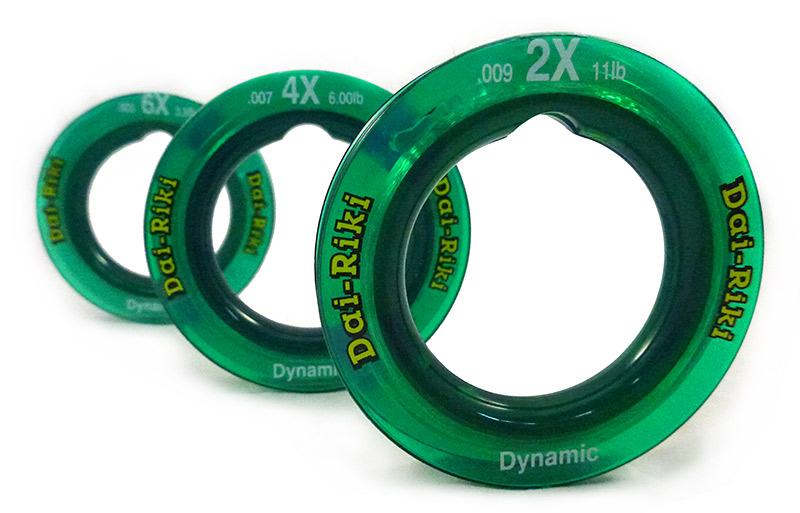

Our guides were some of the first to point out Dai-Riki Dynamic’s is impressive stretch and suppleness. 2X ran very large, but 4X was significantly smaller than the industry average, 6X was slightly larger. Dynamic’s stretch factor and suppleness was very close to TroutHunter nylon, making it an excellent choice for anglers that are looking for a very soft, flexible material to help contend with tricky currents. The increased stretch factor also helps put a damper on violent strikes. We’ve been fishing this material on the spring creeks here for years now, and it has been all aces. Ideal Usage: technical angling where a perfect drift is paramount. Stretch factor also helps dampen the effect of violent hook sets.
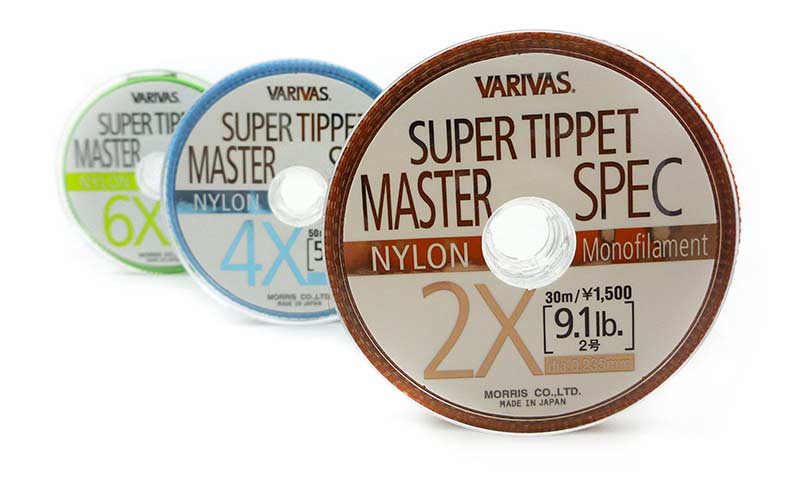

We were actually quite impressed by Varivas nylon. While this product has not been as popular or as readily available as Orvis, Umpqua, or Rio, it proved to be on par with these popular materials. It mic’d out near perfect to their advertised sizes and was only slightly larger in 2X and 6X than the industry average. In 4X it was significantly under, and its breaking strength reflected that, (can’t have it all I guess). In 2X, 1X, and 0X you get the normal 30M, but guides and serious anglers will appreciate the 50M spools in 3X-10X.
A couple down sides, the first was it’s slightly higher than average price of .28 ¢ – .46 ¢ per meter. Also, we found some Varivas spools didn’t click together very well, resulting in the spools eventually separating and in some cases not clicking together at all.
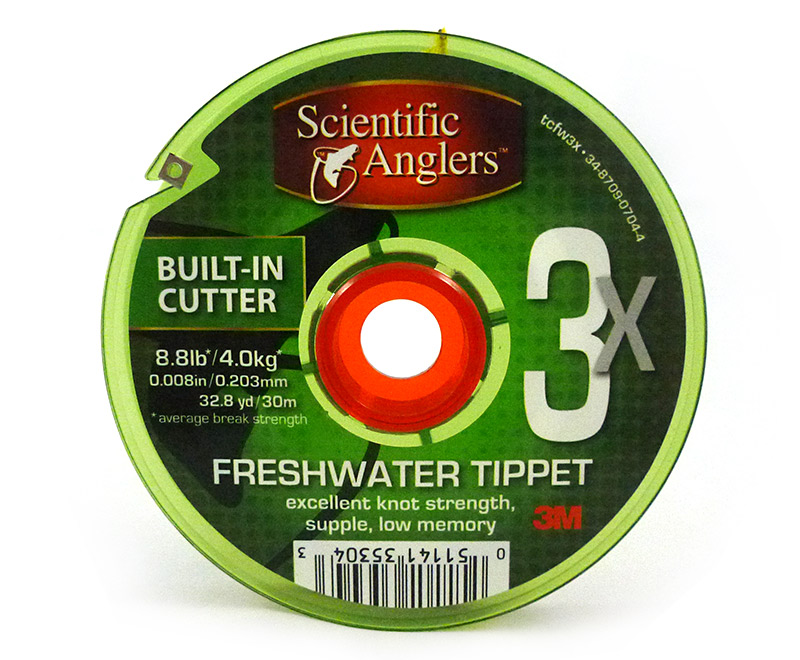

Another material that runs thicker than the industry average in 2X, thinner in 4X, and just over in 6X. While SA doesn’t market this material as being especially supple, we felt it was on the supple side. Consequently it was not one of the stronger materials. We like how they advertise the average break strength instead of their maximum, unfortunately our tests showed that this material broke under their advertised average nearly every time, especially in 6X. This material seemed to be right in the middle of the pack with a solid product at a good price.
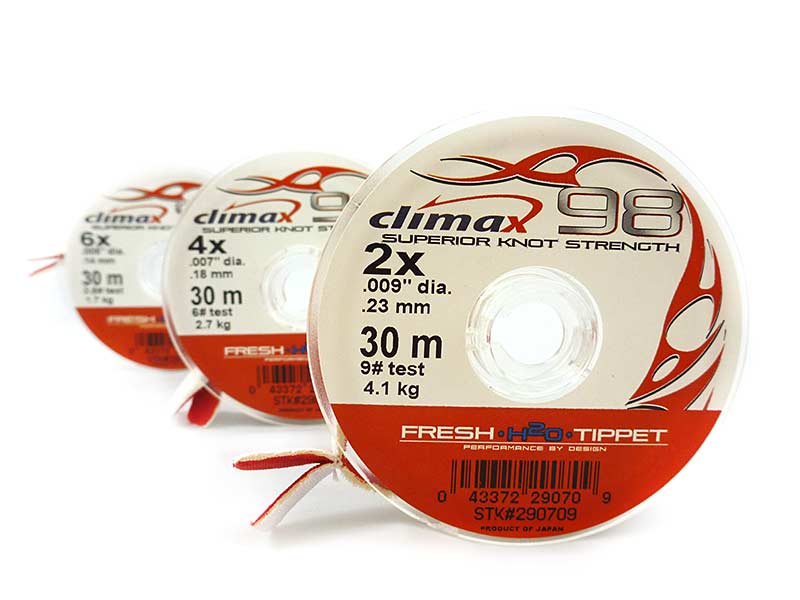

Climax 98 was one of the only materials to mic’ out under both their advertised diameter as well as the industry’s average diameter. In fact, on average Climax 98 was one of the thinnest materials we tested, making it an excellent choice for technical nymph fishing. It is also stiffer than TroutHunter nylon or Dai-Riki dynamic, so for anglers who are looking for thin yet stiff material, this is it. We like their spool design, another clear “tippetmaster” using Rio’s patented design, however we like Rio’s tippet tender better than their white and red neoprene tippet tender. I could see flies getting stuck in it as well, especially with the tag ends hanging out. Buying some Shark Tooth tippet tenders would solve this quickly.
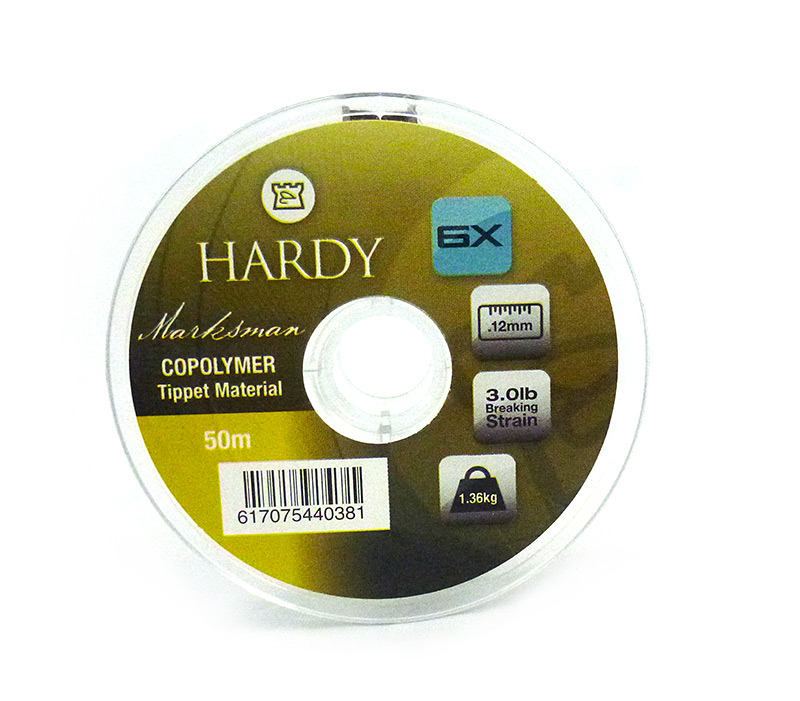

At first glance, Hardy nylon appears to be inferior in strength to most all the other materials. However, when you take a closer look at its size to break strength ratio it is quite strong, especially in 2X and 4X – the difference is nearly a full size thinner in diameter than other materials.
Apparently in Europe and the UK there has been a huge push for manufactures to advertise their size and breaking strength accurately. We probably should have tested Hardy 1X, 3X, and 5X since they would be equally as thick as everyone else’s 2X, 4X, and 6X. Unfortunately we didn’t become fully aware of the diameter difference until it was too late. One thing’s for sure – the price is right! It is one of the least expensive materials out there per yard…
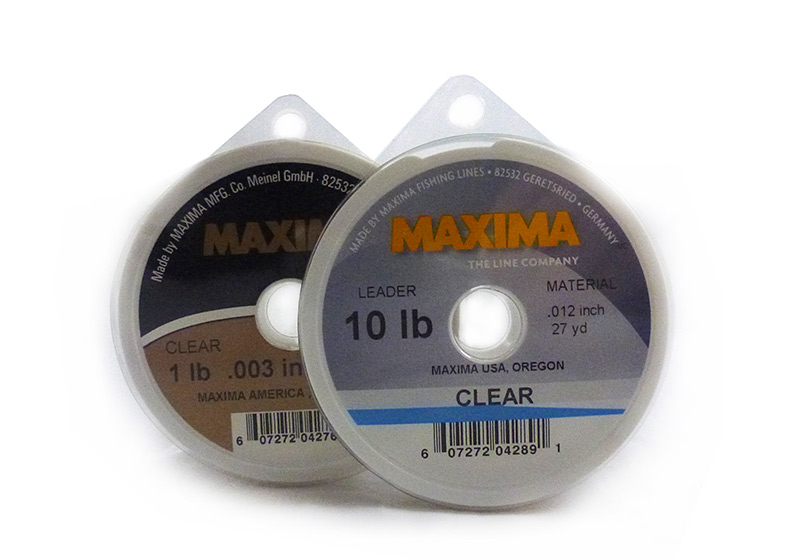
Maxima clear nylon is a great product, and is our choice of material for the butt sections in our hand tied leaders. It is also great tippet material for steelhead or for streamer fishing here on the Yellowstone in slightly off color water.
We were utterly shocked to see how weak Maxima tested in thinner diameters, (2X-6X). Not only was Maxima Clear thicker than the industry average in 2X, 4X, and 6X it also had significantly weaker breaking strengths, even when compared to brands with thinner diameters – ouch!
Immediately we tested some larger sizes and were relived to see that 10 pound maxima was actually breaking at 15 lbs. 15 lb. Maxima was breaking at 20 lbs. Clearly Maxima has the most amount of work to do with correcting their advertised size and pound test.
Maxima offers nice large arbor tippet spools but no tippet tender (other than the plastic hangtag cover that never stays on). These spools are the perfect candidate for an orange shark tooth cutter tippet tender. The size of the spools are a bit cumbersome for lanyard or for pockets, but are fine for a boat bag. Also, there is no way to clip spools together so plan on coming up with a tippet leash of some kind if you want to keep them together.
Ideal usage: Larger sizes (10 pound and up) for building mid and butt sections for leaders. Also as tippet material for streamer fishing, as this stiffer material really helps turn over large, heavy weighted streamers and other big flies.
We Do NOT recommend purchasing Maxima clear in 2X or smaller, get Rio Powerflex instead which is much thinner and stronger.
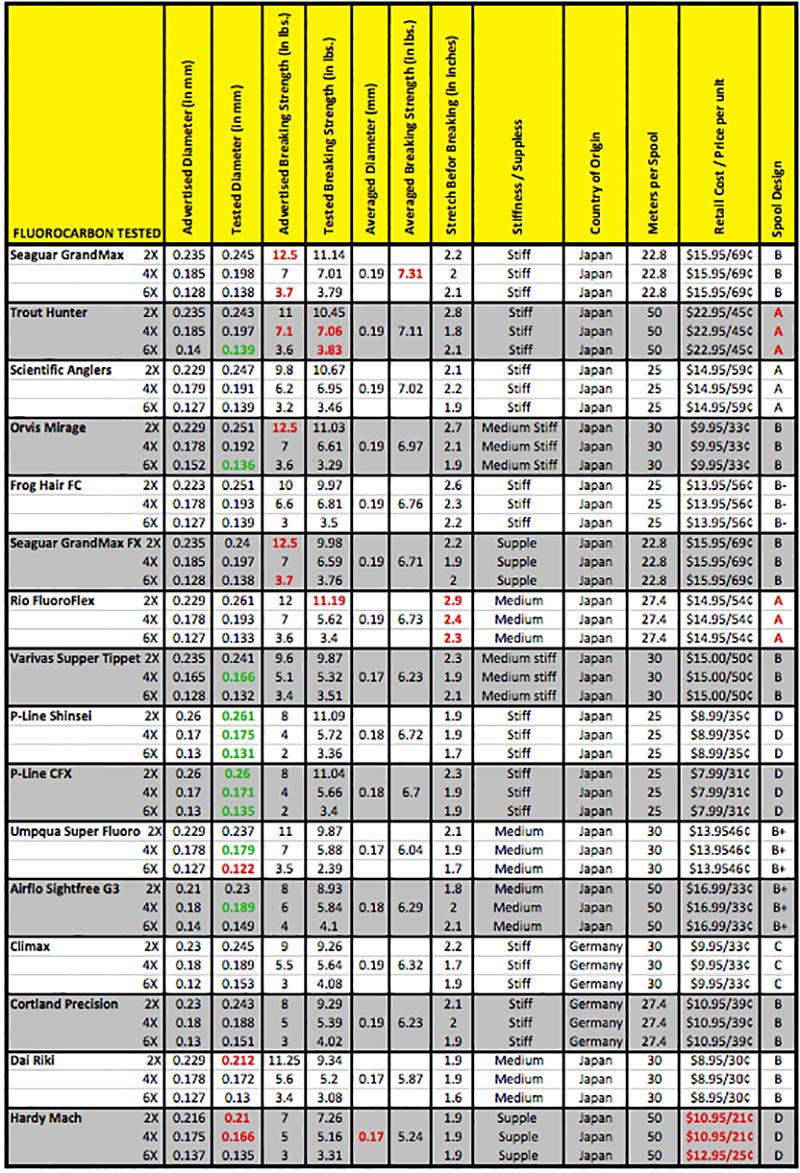


G-Max, as we call it in the shop, has been our go to fluorocarbon for 10 years. Tested with time we know for a fact that this material holds up better than anything while also providing excellent knot strength. As the inventor of fluorocarbon, Seaguar has created one of the best double structure extrusion processes in the world. Seaguar’s double structure design consistently placed it at the top for knot breaking strengths. The only downside we found was the cost. At .69 cents per meter it is the most expensive material we tested. That being said, it still remains one of our top selling tippet materials. If you are not as concerned with price and are looking for the ultimate performance, this material is the best money can buy…
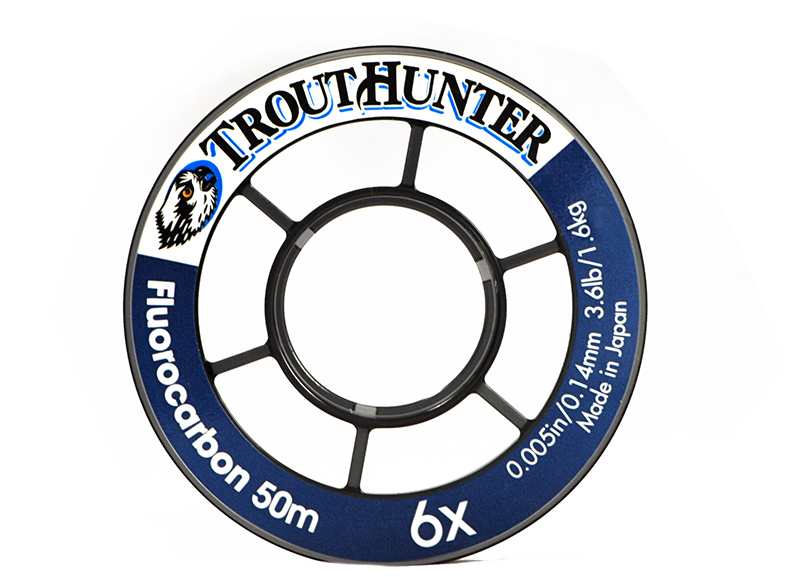

In Our Closest Shootout ever, TroutHunter is our 2012 tippet shootout winner by a hair. While TroutHunter’s double structure fluorocarbon produced equal straight pull breaking strengths and knot strengths as Seaguar, it’s cheaper price per meter, the availability of “half sizes,” and it’s outstanding spool design gave it the edge.
The test results were suspiciously close between TroutHunter Fluorocarbon and Seaguar GrandMax, so close in fact that we actually called Seaguar and asked them if they extruded TroutHunter. They said “no” but we are still a little skeptical.
While the $22.95 price per spool may produce sticker shock, at .46 cents per meter it is still a great value. You get 50 meter on each spool of TroutHunter compared to 23-30 meters on the competitive spools.
(Note* 03X, 02X, and 01X come in 25 meter spools from TroutHunter).
TroutHunter fluorocarbon pulls off the spool perfectly with no line memory or damage to the tippet. There’s not much room for improvement on spool design except perhaps printing what “X” and pound test on their color-coded tippet tenders are, (like Rio). That way, you can tell what X each tippet spool is without memorizing which color is which.
TroutHunter now offers a tippet post, which will accommodate the large arbor spools and also has a waterproof “stash” compartment, (see below).
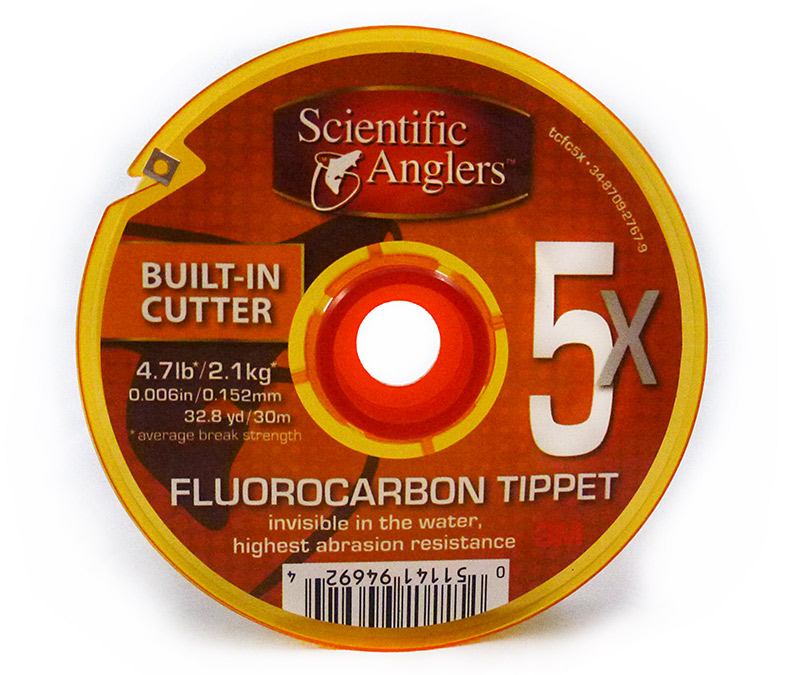

SA’s fluorocarbon stands out as one of the best materials out there. The price, while slightly less than GrandMax, reflects its high quality. We even heard through the grapevine that Seaguar extrudes SA fluorocarbon for Scientific Anglers. We found it interesting that the knot break strengths were not identical to GrandMax however, suggesting to us that perhaps Seaguar keeps very best “double structure” fluorocarbon formula for themselves.
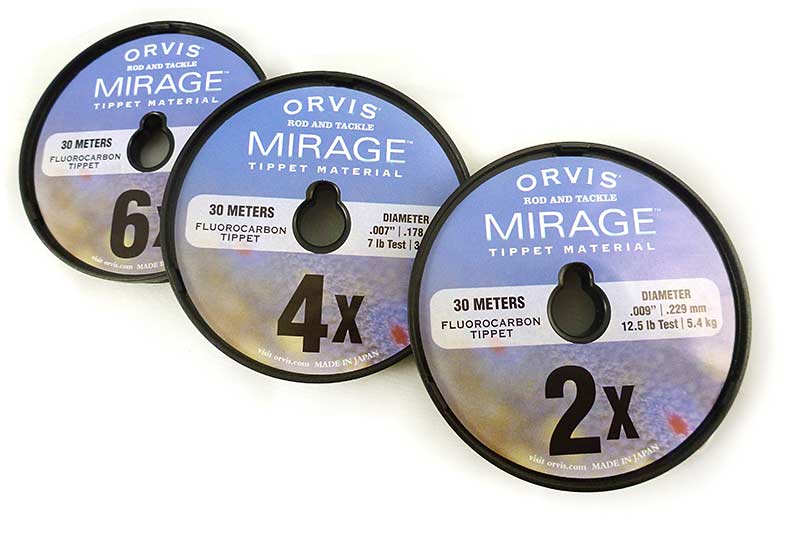

Once again Orvis has a strong following in the shop with their Mirage Fluorocarbon material. While it is significantly larger in 2X, and relatively larger in 4X, their 6X is spot on and very strong. Spring Creek aficionados will appreciate Mirage’s blend of stiffness for casting into the wind, while still remaining supple enough to get a good drift.
Orvis came out with a new spool design this year. We like the switch to black instead of clear, as well as the slightly larger arbor. Also their tippet tender has been improved with a wider brass hole for the tippet to pass through and a wider tender itself, making it easier to read which “X” the materials are. While the spools click together, we feel the old spools were actually easier to “unclick.” This material has been a staple for years and with such a strong following, it looks like it has earned its spot on the tippet wall indefinitely.
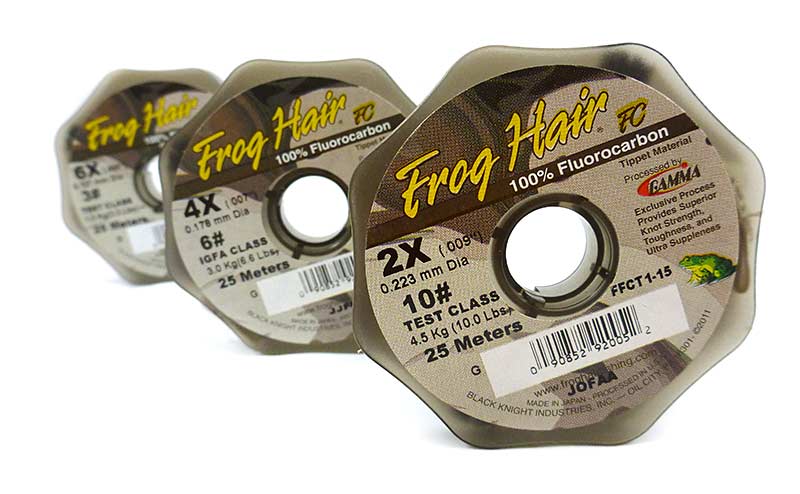

While Frog Hair FC was impressively strong, it appears most of their strength is due to it’s larger diameter. While it was slightly over in 6X, it was actually closer to 1X than 2X and closer to 3X than standard 4X. For anglers who need extra abrasion resistance and less stealth, Frog Hair FC is a great option. For example, perhaps your home river is a fast flowing freestone and you love to Czech nymph or use a lot of split shot, causing your fly (and tippet) to frequently hit jagged rocks and boulders. Frog Hair’s extra diameter will also help in turning over streamers or heavily weighted nymphs rigs.
We like Frog Hair’s unique hexagonal spools. Although not as big as some, Frog Hair spools still qualify as large arbor and are quite thin, making for less bulk when clipped together. The tippet tender is labeled with the correct size “X” and pound test, however unlike other brands there is no brass hole to pull your tippet through. They could probably cut costs a bit by doing away with the black tippet holding tabs (which are not cut deep enough to hold the tippet in place very long). In short Frog Hair FC is very strong tippet but also expect a thicker diameter.
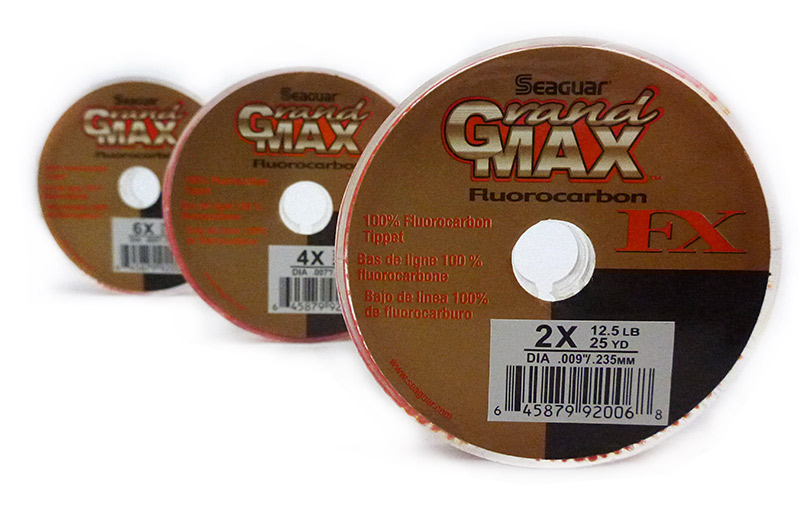

GrandMax FX has been another shop favorite for about 5 years now. While it is not quite as strong as the original GrandMax, it is by far the supplest fluorocarbon we’ve found to date. When facing extremely clear water and complex currents, GrandMax FX gives you the advantage of both worlds – the invisibleness of fluorocarbon yet the suppleness of nylon.
If you are fishing to huge, intelligent browns in the Arkansas River, and you can see the two-foot shapes underwater move away from your fly, tippet, or indicator on purpose, FX may be for you. If you look at the breaking strengths, 6X is actually about the same as original GrandMax. 2X and 4X are slightly weaker, however if you are fishing with a 3 or 4 weight rod, the softer tip and action of the rod should help eliminate any extra break-offs.
We are glad to see Seaguar going back to their original spool design, which clip into each other and are less bulky than their “flying saucer” style spools. While their original spool design is not overly impressive it gets the job done. Since Fluorocarbon holds up well to UV rays, their clear spool is fine. Every now and then a fly will get stuck in the hair tie tippet tender, but otherwise we have no real beef.
Ideal uses: For fooling the most intelligent, conditioned fish on the planet or whenever you need the best invisibility and drift.
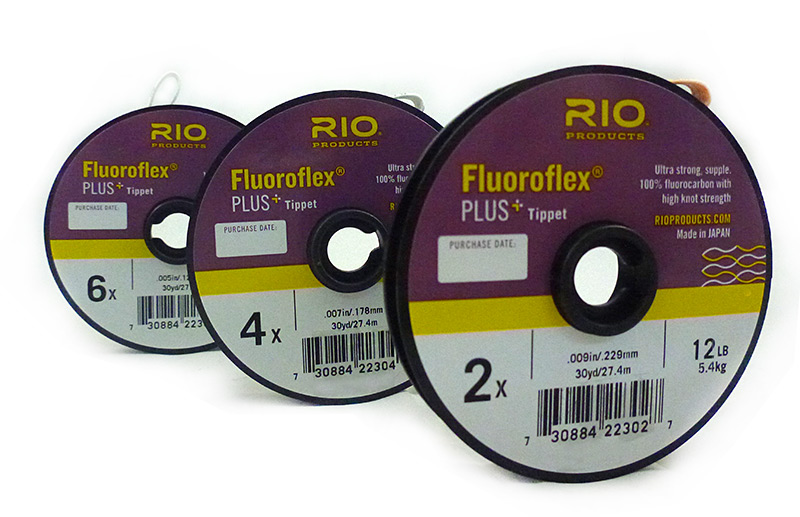

What sets Fluoroflex aside from all the other fluorocarbons is that it has more stretch than any other fluorocarbon we tested. Depending on your point of view, this can be either an advantage or disadvantage. The stretch factor should help with overzealous “rip their lips” trout sets. On the other hand, professional bass fisherman prefer less stretch in their fluorocarbon materials, as less stretch means greater sensitivity, allowing them to feel even the slightest hit or bump.
Rio has done a fantastic job with their spool design, which is why several other companies have either tried to copy their design or possibly pay to use the same patent number on the spools that Rio uses. The spools clip together well, the tippet tenders are both color-coded and marked which X, pound test, kg test, as well as the size in inches and mm. If the tippet comes out of the brass ring, it is a bit of a nuisance to get back in, but nothing terrible. Hard-core anglers and guides will appreciate the convenience of a 110yard “Guide Spool” in addition to the regular 25 yard spool.
The main down side we found with Rio Fluoroflex (and all other fluorocarbon materials other than TroutHunter or Seaguar) was that knot strength was significantly lower. While the Fluoroflex straight pull breaks were just as strong as the TroutHunter and Seaguar, once we tied knots with Fluoroflex it was breaking 1-2 pounds weaker than the double structure fluorocarbons.
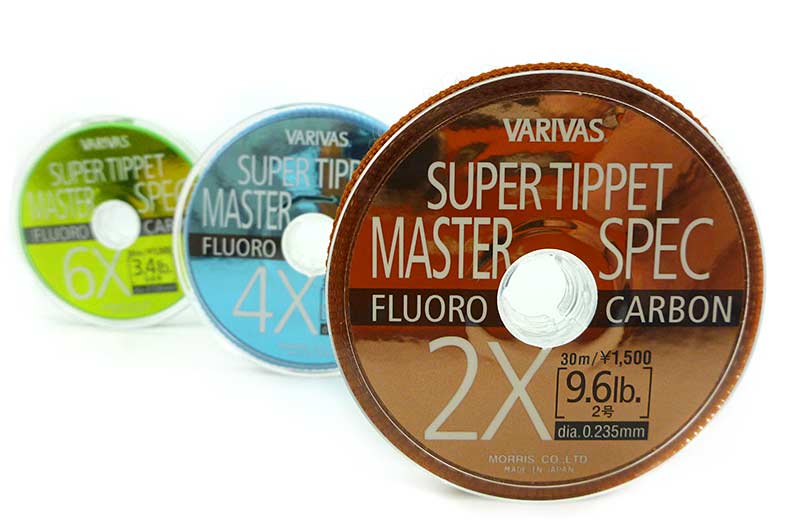

Varivas is right in the middle of the pack in terms of price (.50¢ a meter) and breaking strength. No surprise, 2X was still oversized along with everyone else, but 4X actually tested significantly under the industry standard and just over in 6X. The diameter of the tippet seemed to be directly correlated with its breaking strength. As far as we could tell this material is on par with everyone except our TroutHunter and Seaguar.
While some Varivas spools clicked together well, others didn’t, resulting in the spools eventually separating and in the worst cases not clicking together at all. The spools are transparent on one side allowing UV rays to get through and almost mirror shiny on the other side. While we appreciate the bling, we’re not so sure the fish do, but that’s only if you keep your tippet on a lanyard. At least the spools are large arbor and thin. Plus the material comes off smoothly.
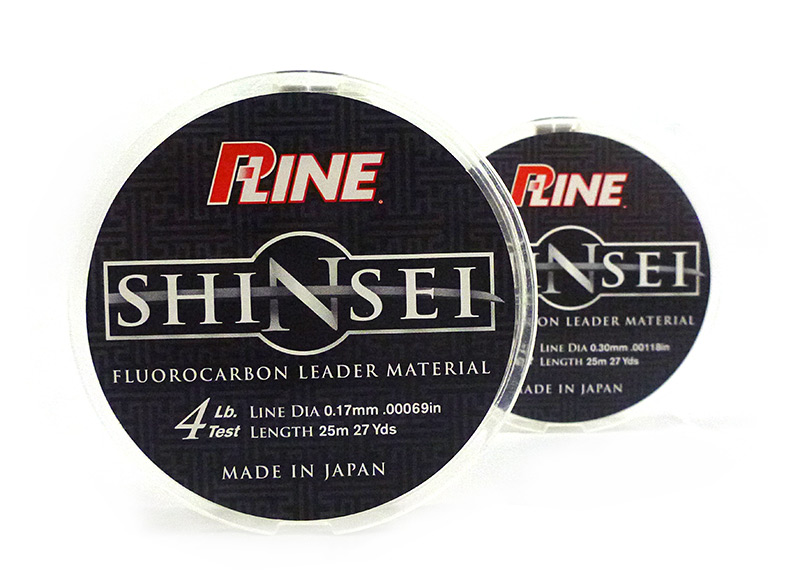

Let’s face it – fishing fluorocarbon can get expensive. If you are looking for the invisibleness of fluorocarbon at a reasonable price P-line is your material. Although P-line brand tippet is almost unheard of in the fly fishing market, it has been exceptionally popular with conventional fishing and on bass tournament circuits. 2X (8 pound test) still ran large, but they came under in 4X (4 pound test) and just over in 6X (2 pound test) compared to the fly fishing’s industry average. They do have very accurate advertised size and our tested breaking strength was stronger than their advertised pound test by over a pound in each size. While P-line makes several kinds of fluorocarbons, with different color tints and blends, we found Shinsei tested the strongest for its diameter. If you have never tried fishing fluorocarbon due to cost, at .35 cents a meter, experimenting with fluorocarbon has never been more attractive.
Although P-line spools are super large arbor, they are quite bulky for keeping 4-6 spools in a vest pocket. These spools are fine for keeping your tippet in a boat bag, as many guides do. The spools don’t click into each other and there is no tippet tender at all. While the grey tippet tab is cut deep enough to hold your tippet, it is prone to falling out.
One of the best prices you’ll find in fluorocarbon. If you consistently rig 6 to 12 feet of straight fluoro, this could be your material.
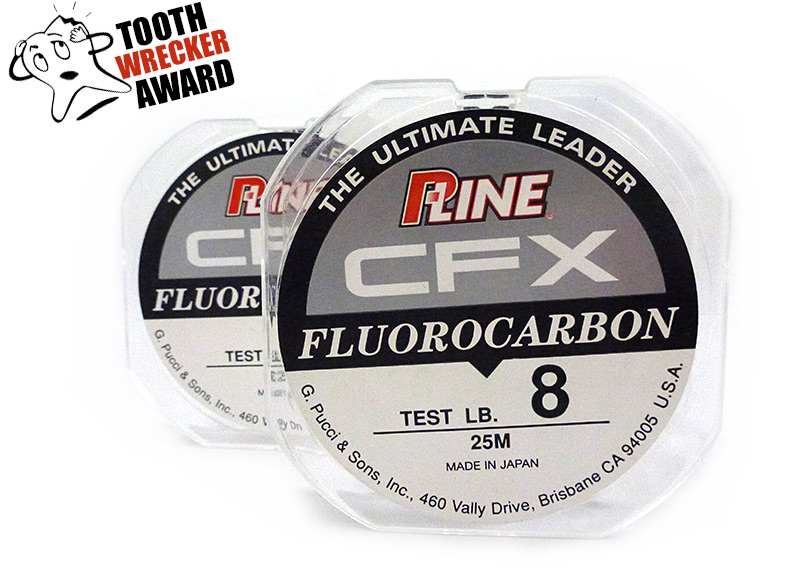

P-Line CFX measured about the same as P-Line Shinsei in 4X and 6X, but actually tested as 1X instead of 2X. Strangely enough, P-line FFX 2X was much thicker than Shinsei. This extra thickness was confirmed when trying to bite through 2X – taking the “tooth wrecker” award of the shootout. OUCH… be sure to use your nippers!
CFX comes on square-shaped spools that are wider than their Shinsei spools, and far too bulky for keeping 4-6 spools in a vest pocket. The spools don’t click into each other and there is no tippet tender at all. While the black tippet tab is cut deep enough to hold your tippet, it is also prone to falling out so you might want to purchase a shark tooth tippet band.
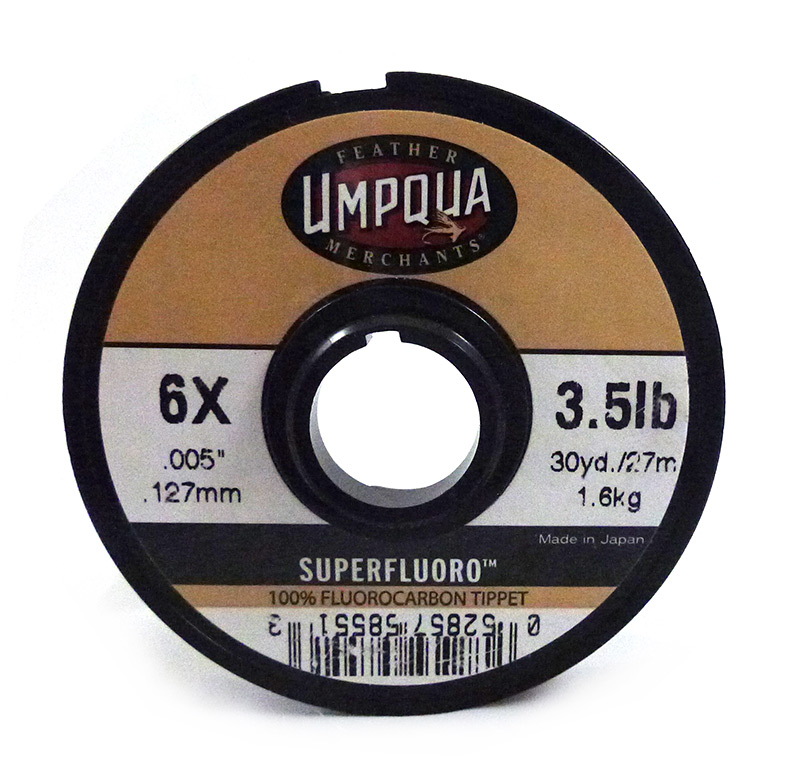

Umpqua’ SuperFluoro ran thinner than many materials we tested, and was the thinnest 6X we tested, at an average of .122, (which is actually closer to 6.5X). It was still over in 2X, (although not by much) and a hair over in 4X. Breaking strength was pretty much equal to all but TroutHunter and Seaguar GrandMax.
Umpqua’s spools are well thought out with black, UV resistant large arbor spools. We like their tippet tender (same as style as Rio’s) except all white with black writing for which “X” and the pound test. Their spools click together well, and once you learn to adjust your grip while pulling tippet off, the material comes off smoothly.
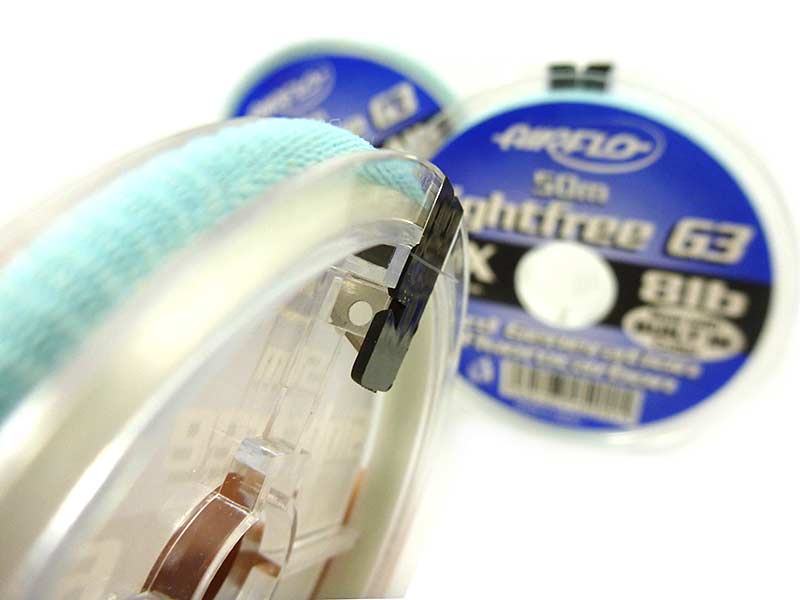

Overall our impression is that it Airflow is a good material, but their diameters vary a lot from one X to the next. For example their 2X was one of the thinnest 2X materials out there, while their 6X had was one of the largest.
The clear spools have a very large arbor, and the “hair tie” tippet tender allows the material to pull off the spool with almost no memory. The spools come with a built in cutter, (although a nipper is still better for trimming the tag ends off your knots). The spools do not clip together, so plan on making or buying a tippet leash.
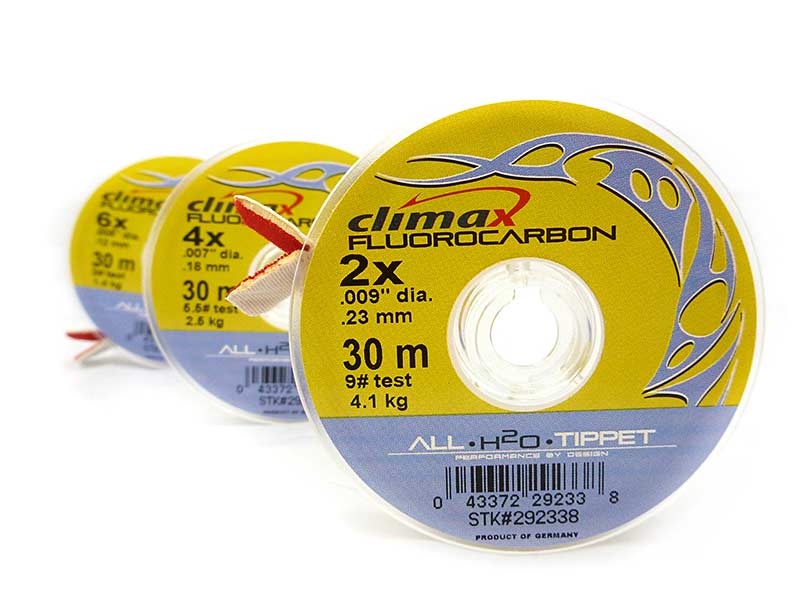

Climax Fluorocarbon is one of the few fluorocarbon materials made in Germany rather than in Japan. The quality of the material certainly seems to be on par with those coming from Japan. The only down side was that it was over sized in both 2X and 4X, and their 6X actually mic’d out to be 5X, at .151 instead of .127 – a full size too big! Breaking strengths good, but also a result from the thicker diameter. Once knots were added, TroutHunter and Seaguar were the stronger materials.
We like their spool design, another clear “tippetmaster” using Rio’s patented design, however their white and red neoprene tippet tender could be improved. I could see flies getting stuck in it as well, especially with the tag end hanging out. Might as well pick up a shark tooth tippet band if you are fishing this material to make life easier…
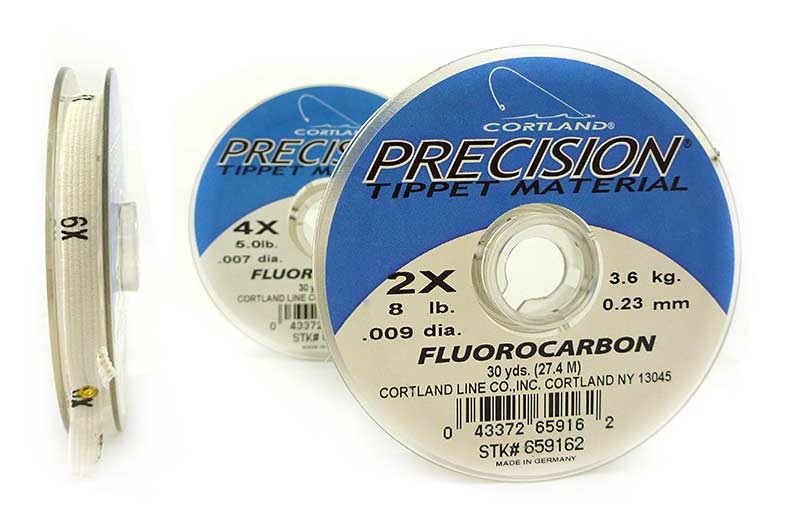

Another German made fluorocarbon, we are not surprised that Cortland Precision is strong and stiff. Interestingly enough, Cortland mic’d out the exact same diameters as Climax in 2X, 4X, and 6X, suggesting it is the same material as Climax. If you are looking for the best price, Climax is a dollar cheaper a spool with an extra 3 meters.
Cortland’s fluorocarbon spools (also produced under Rio’s patented “Tippetmater” spools) do have a different style tippet tender than Climax. Instead of a strip of neoprene sewed together, Cortland’s tippet tender is very similar to Rio’s, stating what “X” six times.
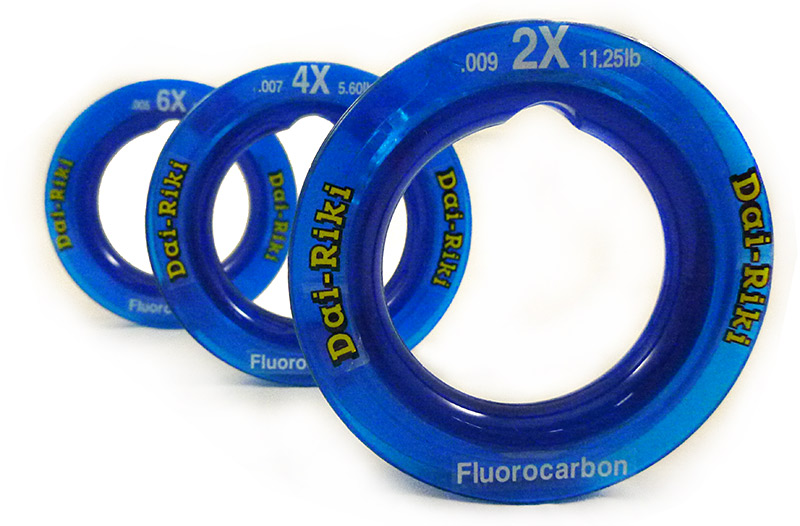

On average, Dai-Riki runs thinner than most fluorocarbons, hence its slightly weaker breaking strengths. Dai-Riki was one of the only materials we tested that matched the industry standard in 2X (measuring .228 it was actually under the .229 standard). In 4X it was .172, .006 mm, (under the industry standard). In 6X it measured a hair over. Unfortunately other brands who are pushing the diameter limits end up looking like superior materials, but that is primarily do to their larger diameter size. Anglers who are more concerned with getting the ultimate drift will appreciate the thinner diameters.
This is a strong material at a one of the best prices out there, plus one of the few who actually have correct diameters and are not oversized. Another spool we recommend using a shark tooth tippet tender with since the plastic tippet tender sometimes “hops” up and down when pulling tippet off the spool.
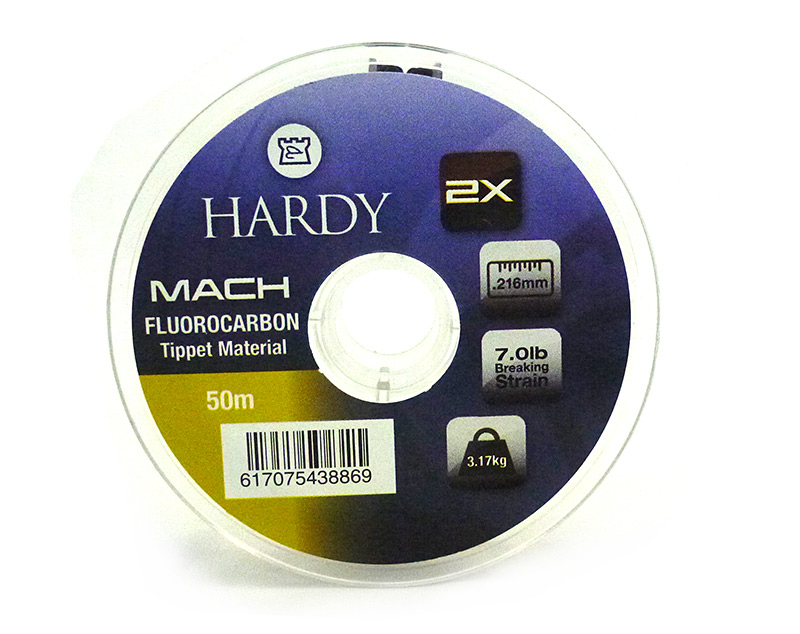

At first glance, Hardy fluorocarbon appears to be significantly weaker than other brands. However, when you take tippet diameter into consideration, Hardy fluorocarbon is clearly equivalent in strength to the other materials.
The biggest difference is that it is much thinner than all the “US” sold brands. Apparently the reason for this is that in the UK there has been a big push from both the retail side and European fishing tackle association to tidy up misrepresented sizes and breaking strengths. Basically, the “tell the truth” on your spools is being enforced in Europe, while the US market is more lenient on advertised size and breaking strength, which is why popular US brands continue to push the limits of their diameter in order to increase their breaking strength.
While Hardy was spot on in their 6X for the industry average (advertise .127 and tested .127) their 2X and 4X actually comes in significantly under. Hardy Mach had the thinnest 2X by far, (at .214) and the second thinnest 4X (.165) after Varivas. While we appreciate Hardy’s efforts to keep diameters smaller, we think there is a little wiggle room for slightly larger diameters (and hence stronger breaking strengths). For now, anglers who are looking for similar diameters to US brands might consider buying 1X, 3X, and 5X Hardy Mach.
The good news is that Hardy Mach fluorocarbon is one of the least expensive on the market per yard.
The major down side to Hardy Mach is the spool design needs work. The spools are exceptionally bulky compared to other brands, don’t clip to each other very well, and the “hair tie” tippet tender doesn’t even match the width of the spool, exposing your material to direct UV light.
________________________________________________________________________



After observing straight pull break strengths vs knot breaking strengths on the machine, we decided to take our experiment outside to simulate real fishing situations. We wanted to see if the tippet-to-tippet knot really was breaking more often the fly knot. For violent shakes and near rod-breaking strikes, it seemed like the rod was able to place more torque on the fly knot, while with the slow pull, rod tip pointed at the fly “bush breaks” the tippet-to-tippet knot was usually the weakest link.
Unfortunately we were again faced with too many variables to determine the weakest link. Out of 10 rod shaking breaks 7 knots broke at the fly, 3 at the tippet. Out of 10 “bush breaks” 6 tippet-to-tippet knots broke and 4 fly knots broke. To really reveal solid data, we would have liked to test each break off simulation 50 or 100 times. As fun as that would have been, we just decided that both knots are important.
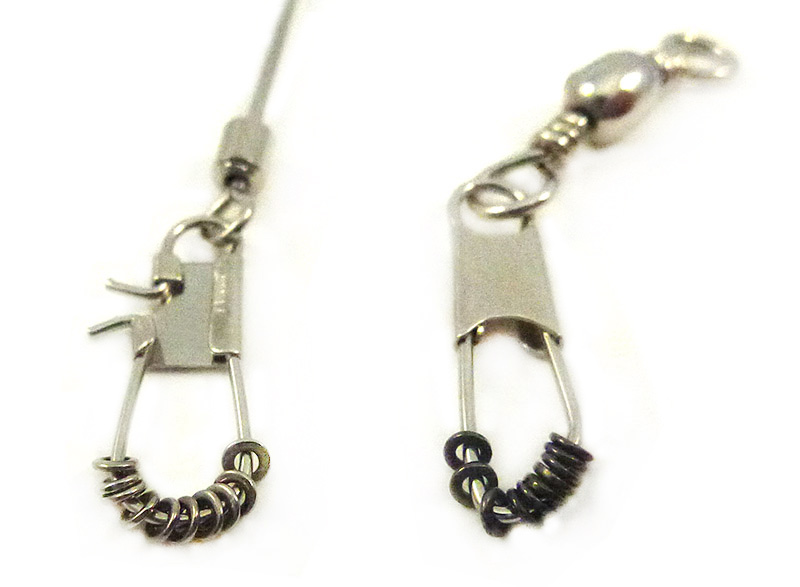

If you are looking for the strongest way to get from a thicker material to a thinner material, we discovered that using a small metal swivel or tiny metal O-ring beat out the breaking strength of any of the tippet-to-tippet knots we tested. We found any tippet material (especially fluorocarbon) produced stronger knots when the tippet was tied to a small metal swivel or metal tippet ring, rather than being tied to another piece of tippet. For example you can tie the butt section of your leader (let’s say 2X) to a tippet ring using an improved clinch knot, and then tie your tippet (let’s say 4 or 5X) to the other side of the tippet ring using an improved clinch knot. We found that time and time again this method of connecting your terminal tippet is stronger than when you tie the 4 or 5X tippet directly to the 2X tippet, even with the best tippet-to-tippet connection knots like the J-knot or Stu Apt Improved Blood Knot. Some anglers feel that adding a tippet ring is outside the realm of true fly fishing, and is more spin oriented. All we can say to that is to each his own…
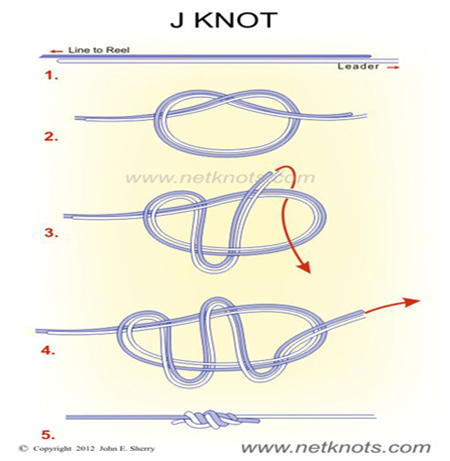
None of us expected much from the “J knot,” but we figured just to cover the bases we needed to test it. After a few incredibly loud breaks at the tippet-testing machine, our view changed quickly. At least for knots tied with 2X to 4X, 4X to 4X, and 4X to 6X, the J knot proved to be the winner for the strongest tippet-to-tippet knot we tested.
This knot is basically a Triple Surgeons knot, except instead of wrapping around the formed loop three times the same direction, you weave your material in and out of the loop. We think the reason it is significantly stronger is due to the fact that the wraps align themselves very symmetrically when pulled tight, perhaps giving the knot more equal distribution when put under stress.
Out of 22 knots we tied and tested, this is one of the few knots you should add to your tippet-to-tippet repertoire as it is easy to tie and incredibly strong. The only drawback to this knot is its slightly larger profile when compared to a blood knot or Stu Apt improved blood knot.
If you are not familiar with the rest of the knots in our charts, you can go to netknots.com to learn them. Then click on the “fishing knots” button and scroll through the many options to find the one you are interested in learning. We found the animation especially helpful in learning each knot.
By Double Blood knot, we mean that you are double overing each side of the material, (in the same way that you double over one side of tippet when tying a Stu Apt improved blood knot). The Double blood is tied by doubling over both sides before you tie your blood knot. The knot tested very well, and for whatever reason, was exceptionally stronger than other knots when tying the same diameter line to each other, (for example 2X to 2X, 4x to 4x, or 6X to 6X).
The good news is if you already know the blood knot, the double blood and Stu Apt improved blood knot will be easy to learn. For the double blood, start by “doubling over” about 8 inches of tippet on both the tippet materials you are tying together. Once you get more proficient at this knot you can cut this down to 5-6 inches, but for learning purposes a little extra tippet will help you pull this knot up correctly.
When the knot is finished, it should have two loops and two tags, (like the bow on a gift or the knot most people use to tie their shoe laces). Since you’ll be cutting off the loops and tags, it would be a good idea to purchase a bio pod or something to throw your excess tippet in.
The main drawback to this knot is that you’ll go through a lot more material. Also in order to get it to seat correctly lip balm is a MUST, especially with fluorocarbon.

George has been fishing this knot for about 25 years, for both saltwater and freshwater. Although the J knot tested stronger, this knot is thinner and quicker for most of us to tie. For fishing spring creeks fishing this knot is one of the best, as it is produces a super slim and strong knot. With this knot, you double over the smaller tippet (so if you are tying 2X to 4X, you’ll want to double over the 4X side) before starting your blood knot.
We’ve also noticed if you are trying to jump gauges (say from 1X to 3X or even 1X to 4X). While your leader may not turn over as perfectly if you took the time to tie in 1X to 2X to 3X to 4X, it is a great time saver for those blizzard hatch situations when you need to get a fly on the water again as fast as possible.
You might end up wasting a little more tippet with this knot than a normal blood knot, but the difference isn’t staggering and the added strength is well worth it. We use this knot in all of our hand tied leaders for the final tippet section.
We started off testing the double surgeons, but after comparing a few breaks it was clear the triple was the stronger knot. The difference in material and time it takes to tie the triple surgeons over the double is so insignificant that we decided the triple makes more sense.
As with the Double Surgeons, you want to be sure to pull this knot together smoothly in one pull, (rather than having to pull each tag individually). The manner in which the wraps seat themselves is more important to the consistency of this knot than the other tippet-to-tippet knots. If you accidently pull ½ of the knot together before the other ½ your knot could be 10-15% weaker than when the knot is seated evenly.
The downsides are a slightly larger profile and also the inconsistency with this knot is higher than with other tippet-to-tippet knots.
The blood knot is one of our favorites, and is the knot we use for building our hand tied leaders (the last section is a Stu Apt improved blood knot). The blood knot is slim, clean, and very consistent. As a tippet knot, obviously the improved blood knot, double blood, and J knot are stronger knots and make more sense for your final tippet-to-tippet connection.
Aside from testing slightly weaker than other tippet-to-tippet knots, we can’t think of any downsides.
While the Seaguar knot is a fun knot to tie for knot aficionados, it’s likely too complicated for the average angler. If it tested as strong as the J knot it would be definitely be worth adding to your quiver, but since it tested weaker than most tippet-to-tippet knots in 2X, 4X, and 6X, we feel it is not worth your time to learn it.
The main drawback to this knot is that it’s relatively difficult to tie.
Another fun knot for those who have mastered of the art connecting one line to the next. This is actually the same knot we use for mono core sinking lines like the streamer express or the Rio Outbound lines. We’ve been calling it a back to back nail knot, which is extremely strong when tied with the end of the fly line and 30 pound maxima. We thought for sure it was going to be the ultimate terminal tackle knot, however as we found out, with the smaller 2X-6X diameters this knot is not very reliable.
Many drawbacks: It takes a long time to learn this knot, it takes a long time on the water to tie this knot. While it is a super bomber knot for fly line connections, it’s not strong enough when using 2X and thinner line.
We found out about this knot on netknots.com. Apparently it originated as a quick and reliable way to tie heavy “iron” tuna jigs. This knot is a close cousin to the 16/20 knot, (named after an elite club of anglers who have caught 20 pound Atlantic salmon on a size 16 or smaller dry fly). The difference is all about how the knot pulls together. With the 16/20 you can hear a “pop” when the knot fully seats itself. With the San Diego Jam, the knot pulls down smoothly, leaving a small loop to pull tight with your tag end. It seems to us the “popping” sound of the 16/20 could actually cause damage to the tippet material, at least for tippet that is 2X or smaller. Testing these two knots head to head confirmed our suspicions.
Downsides? Not many. All we can think of is you have to use a little more material and take the time to learn it. You really should add this knot to your repertoire.
This knot came to us after tying the double Uni and double blood knots. We expected the double improved clinch to be stronger, but as it turns out the Double Clinch proved superior time and time again. It must have something to do with how the wraps hold under stress, and with the doubled up material there is less slipping involved, making it unnecessary to go back through the improved way.
The good news is most everyone already knows this knot. If you have a larger fly like a hopper, rubber leg, or streamer simply double the material over before threading it through the eye of the hook. If you are fishing smaller flies (#18 and smaller you may have to thread the eye, pull about 6-8 inches through and thread it back through the eye, allowing the material to double before tying the knot. Should the special occasion rise where you either have spotted a very large trout or seen them before in a certain run, this is a great knot.
Only drawbacks – slightly larger profile than other knots, it uses more material than other knots.
A true classic and one of our favorites for decades… It is easy to tie and as it turns out it tested very strong. If you were only going to learn one knot for tying your tippet to the fly – this is it! Although the Double Clinch and San Diego Jam knot tested stronger, the improved clinch knot is quicker and easier to tie on the water. With practice, one can pretty much tie this knot while looking at the rising trout, which is also an advantage.
Aside from testing slightly weaker than the San Diego Jam and Double Clinch, we cannot think of any downsides to this pure and simple knot.
The Trilene is another of the few knots worth learning and using. By going through the eye of the hook twice and finishing the knot like a clinch, you are basically adding a little extra padding between the hook and your material. Supposedly, this knot works like a champ with fluorocarbon. Looking back at our data, with fluoro it did test stronger than the Improved clinch, and in 6X, even beat the SDJ and Double Clinch. If you are fishing small technical dries or nymphs with small tippet, this should be your go to link to the fly. Also, if you are tying on a dropper fly to the bend of the top flies hook, you can still use this knot – just wrap your line around the bend of the hook twice before you make your clinch style wraps.
Downsides? Hmm… nothing comes to mind.
As the name implies, this is an improved clinch with the material doubled over. We expected this knot to hold better than the Double Clinch, but in almost every test it turned out slightly weaker. So… use the double clinch instead.
Downsides: an extra step from the double clinch and also weaker. Opt for the double clinch instead.
Commonly referred to as the “non-slip mono loop” or Lefty “Kreh Loop” this knot’s main advantage is adding more action to your fly. In the saltwater world, this knot is very popular for tying on crab patterns. In freshwater, it has become a very popular knot with anglers who fish streamers often. The idea is that the looser line through the eye of the hook will give the fly more action in the water. We think there is some truth to that, although we have also been using the improved clinch with streamers successfully for years.
Downsides: not nearly as strong as other knots, more susceptible to the material being cut by fish teeth, more abrasion can occur from the eye of the hook being able to slide.
The Orvis knot impressed us as a pretty slick knot. In a way, it is an improved Davy knot, since they both start out with the same figure eight. With the Davy you’re done with after a single figure eight, but with the Orvis knot, you wrap your tag through ½ the figure eight again twice. The extra couple wraps seem to do a much better job at holding the knot.
One thing we like about this knot is when you begin to synch it down, there is significantly less friction on the material than say, even a clinch knot. This is a big plus for fluorocarbon materials, which seem to “burn” easier without lip balm or another lubricant. For whatever reason, this knot tested especially strong in 6X nylon compared to other knots.
Downsides? Some knots did test stronger and are easier to tie, but all and all, the Orvis knot seems very reliable and trustworthy.
Note the above knot is a regular uni knot, to tie the “double uni” simply double over about 6-8 inches of your tippet before threading the eye of the hook
Although this knot has the same name as the tippet-to-tippet knot, it is different. Here the double refers to the line being doubled over instead of two knots butted up against each other. Unfortunately none of us cared much for either. The tippet to fly double uni, is difficult enough to tie 2X, a real nightmare in 6X. We were somewhat relieved to see that it didn’t test as strong as the top knots.
Downsides: especially difficult to tie in smaller sizes, use up more material, not as strong as other knots that are easier to tie.
After watching knot wars we expected the Palomar to do much better than it did. We know a lot of bass gear guys who love this knot. Perhaps results varied due to the different size diameter of the line tested. One thing we observed was that most Palomoar knots were 100% knots, in other words, when we looked at the break, the knot was still intact almost every time. While that sounds like a real benefit, unfortunately we think the tippet is causing so much friction on itself when the knot seats that it actually weakens it – right infront of your knot. This is why the breaking strengths did not reflect those of each material for straight pull break strengths, even though most times the knot was still intact.
Downsides: Not ideal for smaller flies and tippet. Tippet material can become injured during the process of pulling it down if synched without lip balm.
We picked this knot out with steelheaders in mind. Unfortunately, even 2X is too small to get an accurate assessment of this knot for steel. Also, we found when testing the snell knot, a hook up eye or down eye can also effect results. (We tested a snell knot with 12 turns with a straight eye nymph hook and later on with a gamagatsu octopus. Although the material was the same size and brand, the octopus breaks were significantly stronger). Typically turle knots are typically used on up eyes, putting more pressure on the shank of the hook instead of the eye. One of the main benefits to using the turle knot has to do more with how the material aligns your hook, hopefully increasing hookup rates when the steel swat at your fly.
Downsides: Doesn’t seem to work as well with thinner diameter materials.
While the regular Uni was easier to than the double, it still seems like there are better knots out there for connecting your tippet to your fly. Although it is supposed to test equally as strong as a clinch knot, our data showed it was significantly less dependable. That being said, we have had 100% success using this knot to tie 20 lb. and 30 lb. dacron backing onto reel spools. (If you get down to your backing to spool knot you’re already in big trouble anyway)…
Downsides: At least for 2X, 4X, 6X tippet, other knots tested stronger
Lesser known as a “bad casting knot” we’ve all created these while fishing. Basically it is a single overhand knot in your tippet. When put under a lot of stress, your tippet will break at this point before many other knots, therefore making it worth while to re-tie some tippet on if you notice one of these in your terminal tackle.
Interestingly enough, in Alaska, guides will actually tie a wind knot in your leader on purpose to hold a bead (egg pattern) in place. The only fluorocarbon material guides trust to do this with is Seaguar GrandMax. With a real shot at a 30 inch rainbow, the guides would not purposely make a wind knot unless they trusted it to hold. After all, a guide’s tip after landing a 30 inch rainbow can be significantly different than an average day or a day of loosing fish after fish.
Downsides: If you use strong tippet-to-tippet knots and fly knots, the wind knot is usually the weakest link in your system.
While we didn’t expect the clinch to be quite as strong as the improved clinch, no one thought it was going to test weaker than a wind knot. Clearly the improved clinch is the way to go. For one simple added step, the improved clinch is a stronger knot with virtually the same finished look and profile. Definitely learn the improved clinch knot instead.
Downsides: One of the weaker tippet-to-fly knots we tested.
The Davy knot was developed for one purpose – speed. In fly fishing competitions, lost time means lost fish, and often lost competition. Once you practice this knot it can literally be tied in a few seconds. Once your muscle memory is trained, you can even tie the knot without looking at it, allowing you to watch for rise forms. It also uses up very little material. Like the Orvis knot, when you pull this tight there is less friction.
The only problem we found with the Davy knot was its knot strength. Reportedly, it is supposed to test nearly 100% break strength. Our data revealed it breaking strengths to be reduced by as much as 40-50 percent. For example, Rio Fluoroflex 2X has a straight pull break strength of 11.19 pounds. After averaging 6 Davy Knot breaks (or slips), breaking strength was reduced to 5.32, which is roughly 52 percent weaker.
Bottom line: This knot is super fast and wastes very little material, however it tested weaker than a wind knot. Unless you are in a competition where time is of the essence, (or fishing to 8 inch trout) it only makes sense to pick a stronger fly knot.
Another “contest” knot that did well on knot wars, we had high expectations for the eye crosser. Unfortunately, it averaged the weakest knot in our test. All we can think of is that this knot does not work as well with thinner diameter materials (2X or smaller). It was also one of our least favorite knots to tie and most likely could never be tied without looking at the knot, no matter how much practice.
Downsides: relatively difficult knot to tie in comparison to others, also the weakest knot of our test.
We tested a handful of other knots (see below) but they didn’t make the cut. In most cases they did not make the cut because their knot strength was either middle of the pack or weaker. Here’s a list of other knots we tested but didn’t include in our charts. Feel free to call us to ask about them if you are curious on how they stacked up:
Tippet-to-tippet: Slim beauty, albright, yucatan, huffnagel, water knot, cove knot, double grinner, double paragun, and double four fold.
Tippet-to-fly: 16/20, Pitzen, Fishi-n-fool knot, Duncan loop, arbor knot, world’s fair knot, improved davy, swivel knot, traditional snell, 12 wrap snell, uni snell, rapala knot, Crawford knot, improved Homer Rhode, and two turn cinch.
Undoubtably there will be some trick knots out there that we didn’t know about or didn’t get a chance to test on the Chatillon
testing machine. Got a knot for us that we should have tested? E-mail us and we’ll do our best to give it a try and report back to you… staff@yellowstoneangler.com
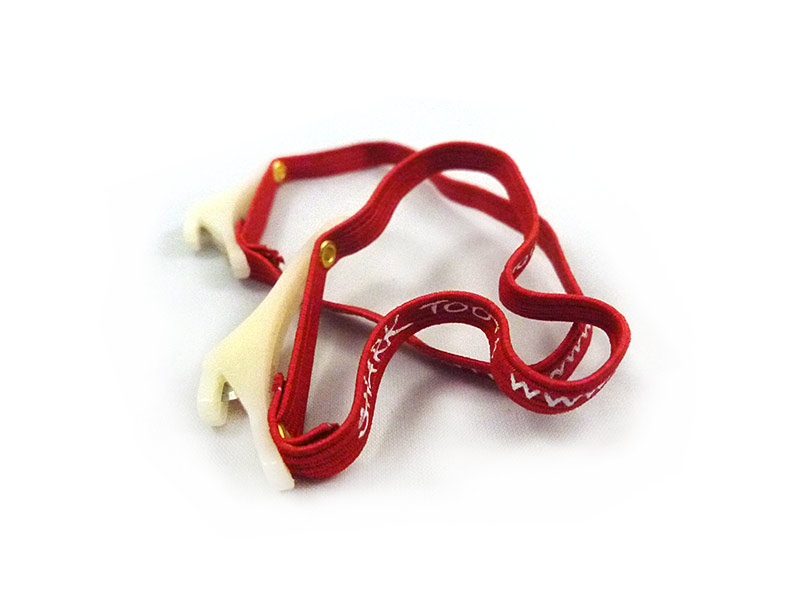

Herein lies a quick solution to spools that have sub-par tippet tenders. The shark tooth tippet cutters are about the same width as a rio tippet tender, with a similar elasticity and brass holes for the tippet to exit through. You can easily take a super fine sharpie permanent marker and add your own denominations such as 2X, 3X, 4X, 8lb. test, .005, or whatever else comes to mind. Aside from managing your tippet material better, the shark tooth tenders also come with a safe razor blade, housed inside a plastic guard. Those of you who have misplaced your nippers and have bitten through 2X or stronger tippet know having an extra cutter on your person is a real bonus. In a pinch, we were even able to use the shark tooth cutter to cut the tag ends off knots within a reasonable length, (certainly close enough to fish with).
Red Shark Tooth Tippet Cutters (larger Spools): Rio Powerflex, Rio Suppleflex, Rio Fluorflex, Scientific Angler’s Fluorocarbon, Scientific Angler’s nylon, Seaguar GrandMax, Seaguar GrandMax FX, Orivs Mirage, Orvis Superstrong, Cortland Precision.
Blue Shark Tooth Tippet Cutter (smaller spools): Stroft GTM, P-Line CXXX, TroutHunter Fluorocarbon, TroutHunter Nylon, Varivas Fluorcarbon and Nylon. (Note – the TroutHunter and Varivas spools are so narrow no Sharkcutter works perfectly, but blue is still the best option).
Yellow Shark Tooth Tippet Cutter (larger / fatter spools): Maxima, P-Line bulk spools.
Orange Shark Tooth Tippet Cutter (smaller / fatter spools): P-Line Shinsei, Dai-Riki Flourocarbon, Dai-Riki Dynamic, Dai-Riki GTS, Hardy Mach, Amnesia.
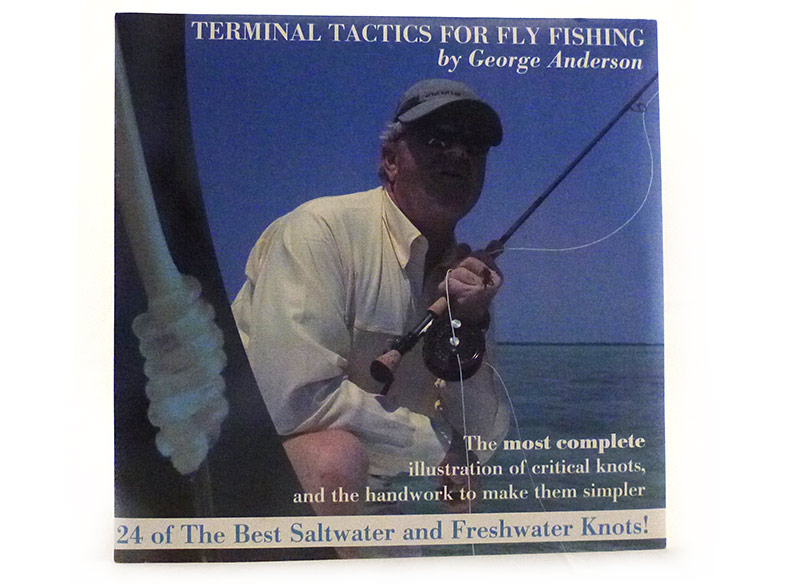

An extremely comprehensive knot tying video from the most simple knots to the most complex. George covers everything you need to know for both fresh and saltwater knots. Learn to rig your own terminal tackle exactly the way the pro’s do. By learning the strongest knots out there, you increase your chances of landing the big one… Knot books are difficult to tell what’s going on, but in this video George shows you exactly how tie the knots, step by step and explains where and when to use them. If you missed something, no problem, just rewind and watch it again. We’re confident that with this video and a little practice anyone can learn to tie the best fly fishing knots in the world.
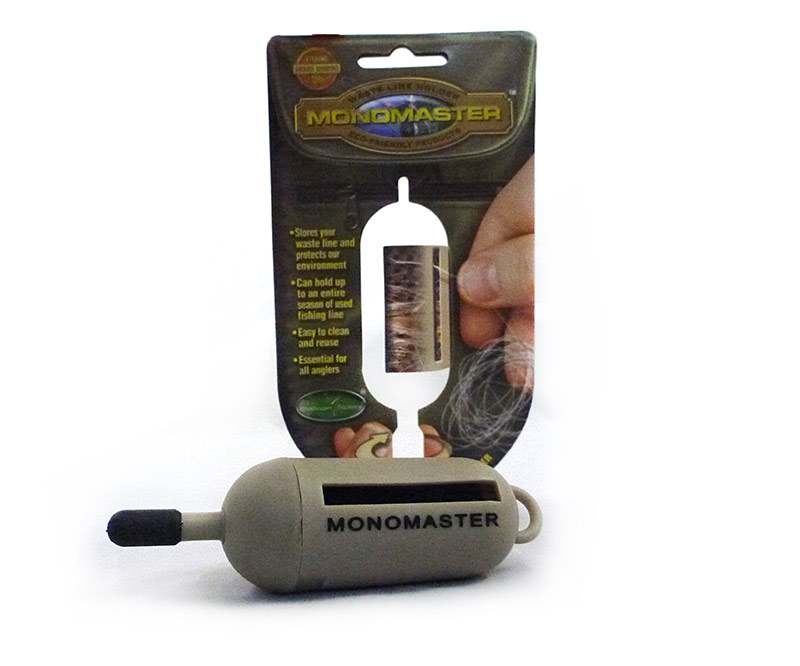

One thing we thought worth mentioning is that Fluorocarbon, by nature, is far less biodegradable than Nylon. Fly Fish America’s article on Flouorocarbon vs Nylon stated that nylon takes 600 years to biodegrade and that fluorocarbon takes 4,000 years.
In the article they mention a material called bioline, (which we purchased and tested along with the other materials). As one might expect, you can’t have it all… while Bioline biodegrades in less than 5 years, it broke significantly weaker than both nylon and fluorocarbon, making it clear to us that users of bioline are certainly more into environmental resposibility than performance.
Our suggestion is to fish nylon or fluorocarbon but to use a monomaster for your used tippet sections, snippits, and waste. It’s not often that you break your whole leader off, but it’s pretty common to add new tippet, clip off tag ends, and throw away old dinged up tippet. For this, we recommend putting those excess pieces in your wader pocket, vest, sling bag, or monomaster…
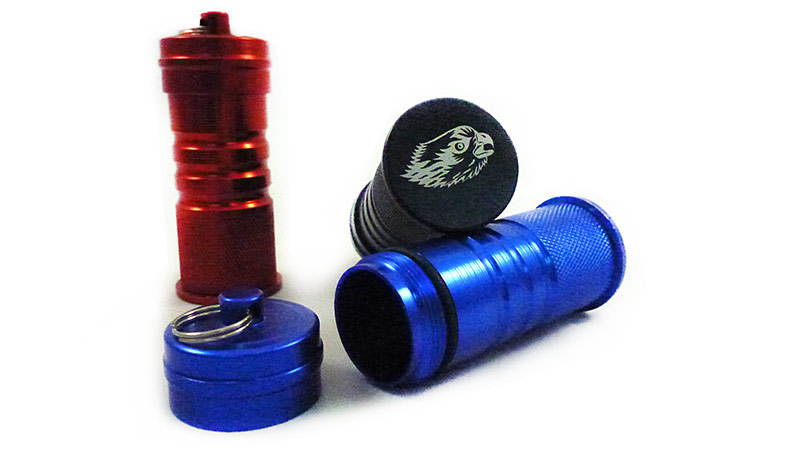

After an extensive search, the guys at TroutHunter finally tracked down a tippet post that will accommodate the unique large arbor design of the TroutHunter Tippet Spool. This post will easily hold 6 spools of TroutHunter tippet material. Central arbor post features a small waterproof stash compartment and lanyard attachment ring. Available in assorted colors.
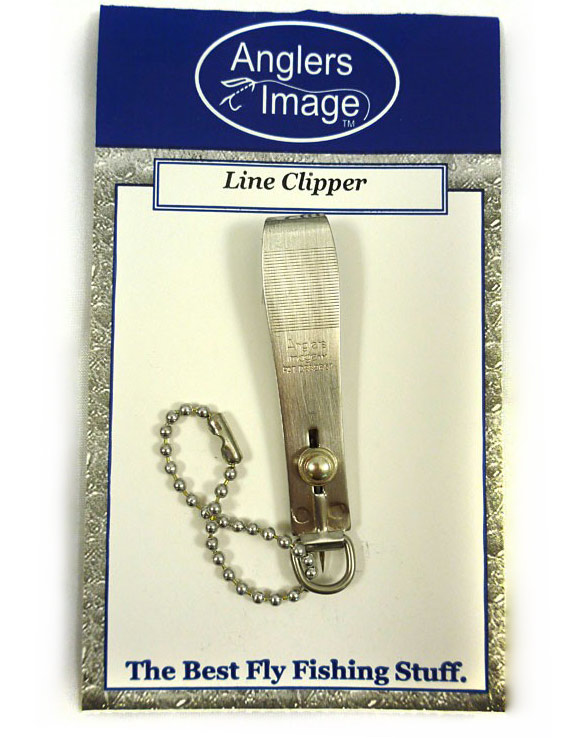

Last but not least – we thought we’d include our pick for the best nipper on the market. It might surprise you that we didn’t pick Abel’s $60.00 nipper or one of Simms’ $30.00 nipper (although we actually sell more of those). Instead of throwing down that much money on a single nipper, you could buy 2-4 $15 nippers by angler’s image – which we feel cut even better.
What makes Angler’s Image line clipper our all time favorite? Simply their ability to stay sharp far, far longer than any other clippers we’ve ever used. Nothing dulls clippers faster than cutting large diameter 60-80 lb. fluorocarbon for tarpon leaders. Most clippers last about a week. These will easily last you two full seasons of 100 days of tarpon fishing and still stay sharp! They come with a sharp retractable needle, good for cleaning out the eyes of hooks, even down to very small hook sizes. In a pinch, we’ve even used this needle on the stream to perform a new needle/nail (the knot between your fly line and leader). The D-ring at top is handy too for holding the hook of your fly while you tie a Homer Rhode loop knot or straighten out your tarpon leader. If you’d rather not have the retractable needle you can purchase the Angler’s Image “nip it” instead, which offers the same cutting jaws as the line clipper.
We hope that you have enjoyed our 2012 Tippet Shootout! With your support, we can continue to give you more shootouts and comparisons on tackle and equipment in the future. But this takes us a lot of time, so if you are in the market for some new tippet we would love to have your business!
Be sure to e-mail us your comments and any questions you have about the exact tackle you need for the fishing you are doing. We’ll be happy to help.
– James Anderson